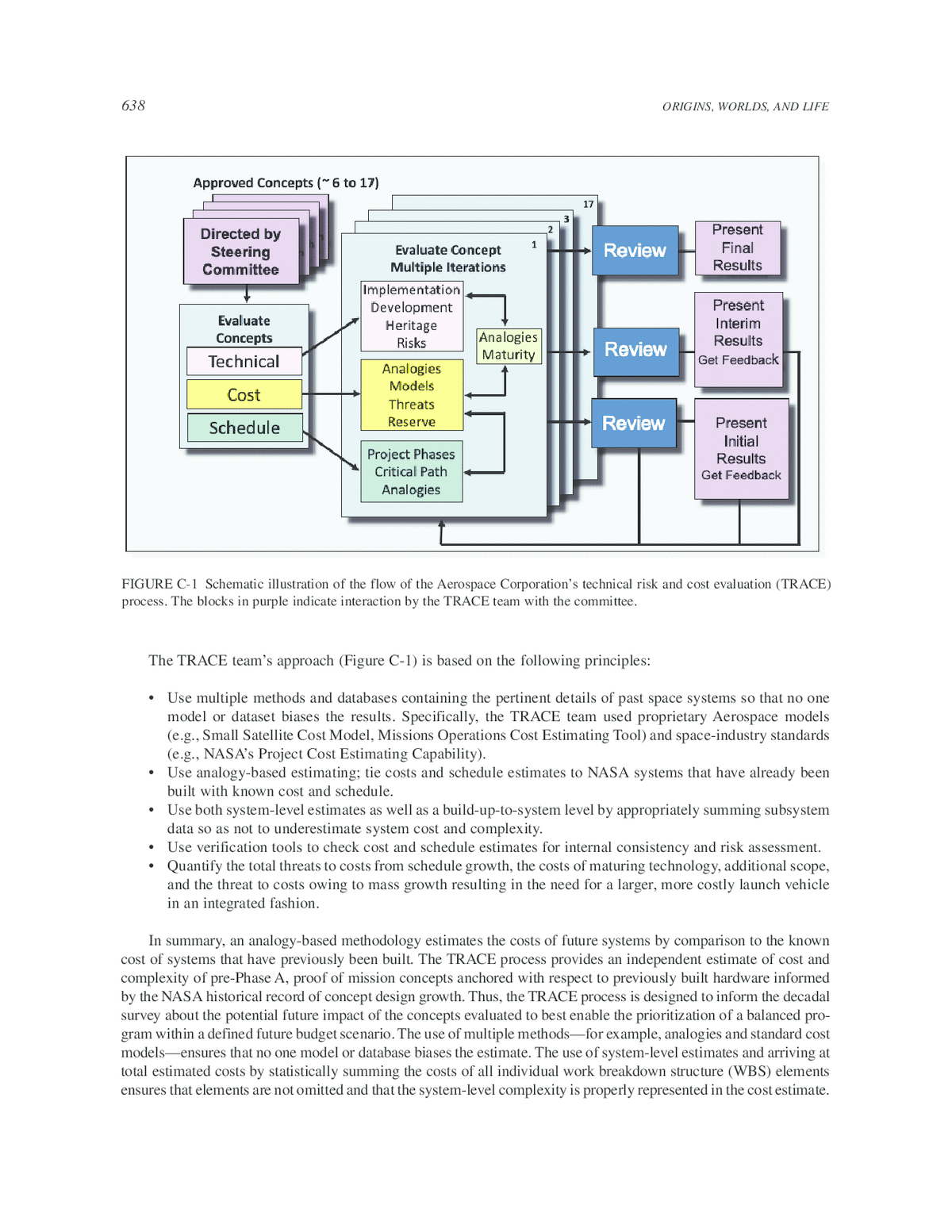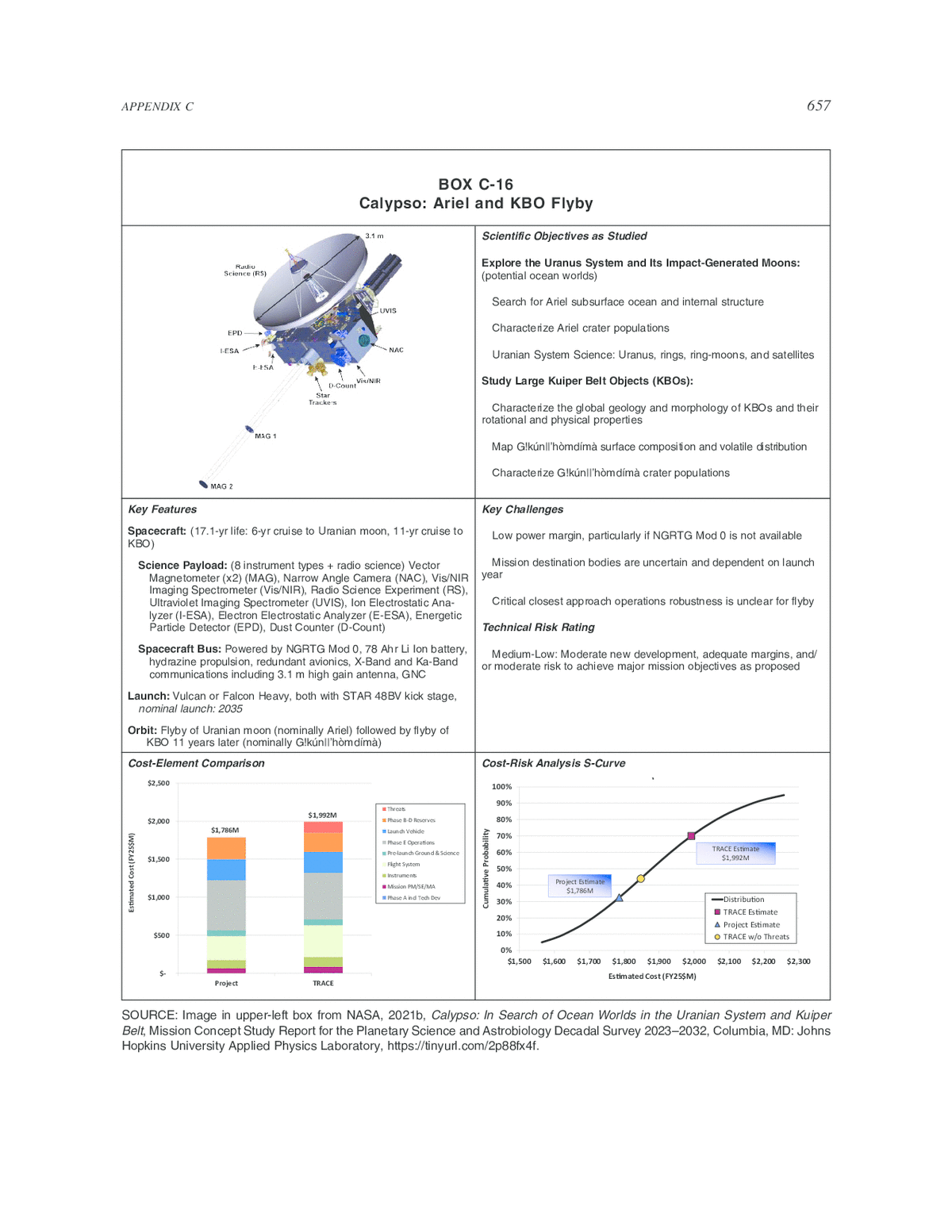Appendix C
Technical Risk and Cost Evaluation of Priority Missions
BACKGROUND
The survey’s statement of task (see Preface and Appendix A) calls for “identifying, recommending, and ranking the highest priority research activities” in planetary science, astrobiology, and planetary defense. However, the identification and ranking of priority activities alone is insufficient. The statement of task mandates that consideration be given to the technical readiness, technical risk, and likely cost of the major activities identified in the survey report. Concern about readiness and risk are not new. Alarm about the accuracy of the mission cost estimates used in past decadal studies was raised in a 2006 report by the National Academies. The latter noted that “major missions in space and Earth science are being executed at costs well in excess of the costs estimated at the time when the missions were recommended . . . in decadal surveys for their disciplines. Consequently, the orderly planning process that has served the space and Earth science communities well has been disrupted, and the balance among large, medium, and small missions has been difficult to maintain” (NRC 2006). As a result, the 2006 report recommended that “NASA should undertake independent, systematic, and comprehensive evaluations of the cost-to-complete of each of its space and Earth science missions that are under development, for the purpose of determining the adequacy of budget and schedule” (NRC 2006, p. 33)
The technical readiness of activities prioritized in decadal surveys and the associated cost estimates for candidate missions were discussed extensively during a lessons-learned workshop convened by the National Academies (NRC 2007a). Workshop participants commented that decadal surveys would benefit greatly if they conducted their own assessments of the technical risk and cost associated with priority missions, rather than relying on NASA’s own estimates. Moreover, the adoption a uniform risk- and cost-estimating methodology would enable cross comparison between competing activities within a given survey (NRC 2007a, pp. 21–30).
The first occasion on which this advice was put into practice was when NASA included a call for an independent evaluation of cost and technology readiness in the statements of task for a review of the agency’s Beyond Einstein program (NRC 2007b). Soon thereafter, Congress recognized the benefit of such evaluations and mandated that the National Academies “include independent estimates of the life cycle costs and technical readiness of missions assessed in the decadal survey wherever possible” (U.S. Congress 2008). This requirement was first implemented during the 2010 decadal survey of astronomy and astrophysics via the use of the so-called cost and technical evaluation (CATE) process (NRC 2010). The CATE methodology was developed by the Aerospace Corporation and is particularly suitable for comparing costs and risks associated with a population of low-maturity mission concepts. Subsequently, the CATE methodology was successfully implemented by three additional decadal surveys, including Vision and Voyages (NRC 2011).
A comprehensive review of the then most recent round of space-science decadal surveys was conducted during a workshop held in 2012 (NASEM 2013) and again in a 2015 consensus study (NASEM 2015). The CATE process was one of the topics examined in detail during both activities. One of the principal lessons learned about the CATE process, as identified in the 2015 report, was that “it is most useful as a reasonableness check on what is being recommended” (NASEM 2015, p. 52). In other words, how does the technical feasibility of one concept under consideration rank relative to its peers? Moreover, the 2015 report found that the details “used to support the CATE analysis are not necessarily indicative of how a mission will ultimately be implemented” (NASEM 2015, p. 52) Therefore, more emphasis needed to be placed on the technical readiness and risk aspects of the evaluation rather than the cost estimation. To reflect this important change in emphasis, the CATE process was revised somewhat and its name was changed to technical risk and cost evaluation (TRACE). The first decadal to implement the TRACE methodology was the 2020 astronomy and astrophysics survey (NASEM 2023).
THE CHALLENGE OF TECHNICAL RISK, COST, AND SCHEDULE EVALUATIONS
The concepts assessed by a decadal survey are typically in preliminary stages of development—that is, pre-Phase A or Phase A concepts. However, the cost of a mission is typically not well understood until it has gone through its preliminary design review (PDR). Even after PDR, unanticipated increases in mass, cost, and schedule can occur. Another challenge to accurate evaluation is the fact that not all pre-Phase A concepts are equal. Some may be more mature than others because more resources have been available during their formulation. Accordingly, ensuring that a mission evaluation is fair and equitable requires that the relative maturity of concepts be considered.
Several different varieties of technical risk/cost/schedule/evaluations are used when discussing mission concepts. The best known are the so-called ICE (independent cost estimates) and NASA’s TMC (technical, management, and cost). A third is the TRACE process adopted by the most recent round of decadal surveys. Each has its own strengths and weaknesses (Table C-1).
The objective of the TRACE process is to perform a technical risk and cost evaluation for a set of concepts that may have a broad range of maturity, and to ensure that the evaluations are consistent, fair, and informed by historical data. Typically, concepts evaluated via the TRACE process are early in their lifecycle, and therefore are likely to undergo significant subsequent design changes. Historically, such changes have resulted in cost growth. ICEs, on the other hand, are usually done later in the lifecycle of a project after it has matured—that is, typically at
TABLE C-1 Similarities and Differences Among Three Different Approaches to Assessing the Technical, Cost, and Risk Characteristics of Spacecraft Missions
| TMC | ICE | TRACE | |
|---|---|---|---|
| Used consistently to compare several concepts | Yes | No | Yes |
| Concept cost is evaluated with respect to | Cost Cap | Project Budget | NASA Budget |
| Maturity of concept | Phases A–B | Phases B–D | Pre-Phase A |
| Evaluation Process Includes | |||
| Quantified schedule growth cost threat | No | Typically | Yes |
| Quantified design growth cost threat | No | No | Yes |
| Cost threat for increase in launch vehicle capability | No | No | Yes |
| Independent estimates for non-U.S. contributions | No | No | Yes |
| Reconciliation performed with project team | No | Yes | No |
| Technical and cost risk rating (low, medium, high) | Yes | No | Yes |
NASA’s key decision points KDP-B and KDP-C and design reviews such as PDR and the Critical Design Review (CDR). ICEs often do not consider certain aspects of cost growth associated with design evolution in the earliest phases of a project. Therefore, a robust process is required that fairly treats a concept of low maturity relative to one that has undergone several iterations and review. TRACE evaluations consider several components of risk assessment (see Table C-1). However, an essential prerequisite for a TRACE evaluation is a particular mission design specified in sufficient detail that it has a concept maturity level (CML) of four or five.
FORMULATION AND IDENTIFICATION OF MISSIONS FOR TRACE
NASA prepared for the planetary science and astrobiology decadal survey via a twofold approach. First, the agency commissioned science definition teams (SDT) and related groups to study various mission concepts.1 The best known of the latter was that for the Europa Lander (NASA 2017b). Second, NASA worked with the planetary science and astrobiology communities via a competitive process to identify, fund, study, and create the appropriate documentation for 11 predecadal planetary mission concept studies (PMCS).
The survey’s six panels reviewed the SDT and PMCS mission study reports and assessed those concepts proposed by the community in white papers and prior proposals (e.g., Vision and Voyages mission study reports). Then the panels identified 18 additional large- and medium-class mission concepts (including a pair jointly developed by two panels and one proposed by a cross-panel group) that could address key scientific questions within their respective purviews. Following documentation by their originating groups, the steering group assessed each one and selected nine for additional study.
To ensure that all mission concepts are mature enough for subsequent evaluation by the TRACE team, the nine concepts were sent for detailed technical studies: three each at the Jet Propulsion Laboratory, the Goddard Space Flight Center, and the Applied Physics Laboratory. One or more “science champions” drawn from the ranks of the panels was attached to the mission design teams at each of the centers to ensure that the concepts remained true to the scientific and measurement objectives of their originating panel.2
A tenth study was later initiated by JPL to create a series of low fidelity (CML-2) concepts addressing planetary defense objectives (see Chapter 18 for details). None of the resulting small-class mission concepts were submitted to the TRACE team because the survey’s statement of task did not call for the prioritization of such likely low-cost missions.3
Once the nine additional studies were completed, the scientific and technical feasibility of the resulting concepts was assessed by their originating panels. Also assessed by the panels were those PMCS and SDT concepts of relevance, and two additional concepts that had been contenders in the competition for the fourth New Frontiers opportunity.4 Following deliberations and prioritization by their respective panel, the most promising mission concepts were forwarded to the steering group for additional discussion and an independent, multistep ranking process. The outcome of that process was that the 17 most promising concepts (one with two variants) were identified and submitted to the TRACE team for evaluation.
In summary, from an initial group of 33 concepts, the survey’s panels and steering group identified 17 missions, each of which had been studied to a sufficient fidelity to undergo the TRACE process. A full list of all of the missions considered by the decadal survey, their origins, and ultimate disposition can be found in Table C-2.5
___________________
1 It is important to note that not all such activities resulted in concepts of sufficient technical maturity—e.g., NEX-SAG (NASA 2015), Ice Giant (NASA 2017a), and ICE-SAG (NASA 2019)—to be submitted for TRACE analysis without additional work. As such, the work of these groups was used as input to the survey’s mission formulation deliberations.
2 The full mission study reports for the nine concepts identified by the decadal survey are available at https://tinyurl.com/2p88fx4f.
3 The complete final report of the planetary defense rapid mission architecture study is available at https://tinyurl.com/2p88fx4f.
4 Required to ensure that representative concepts responsive to the New Frontiers 4 and 5 Ocean Worlds mission theme undergo technical risk and cost evaluation and thus remain potentially viable candidates for future New Frontiers opportunities. Full study reports for these two missions are available at https://tinyurl.com/2p88fx4f.
5 A notable omission from Table C-2 is the Venus In Situ Explorer. This concept did not undergo TRACE analysis because the survey committee concurred with Vision and Voyages’ decision that the phase-A study—conducted when a concept responsive to VISE was in the step-two competition for the third New Frontiers launch opportunity—was equivalent to or better than a CATE. “The committee assumes that the ongoing NASA evaluation . . . has validated [its] ability to be performed at a cost appropriate for New Frontiers” (NRC 2011, p. 15).
TABLE C-2 Mission Concepts Considered by the Decadal Survey for Technical Risk and Cost Evaluation
| Name | Origin | Disposition | Additional Information |
|---|---|---|---|
| Mercury Lander | PMCS | Selected for TRACE | NASA 2020g and Appendix C |
| Venus Flagship | PMCS | Selected for TRACE | NASA 2020k and Appendix C |
| Venera D | SDT | Not selected for TRACE | Venera-D 2019 and Appendix D |
| VISAN: Venus In Situ Seismic and Atmospheric Network | PV | Not selected for study or TRACE | Appendix E |
| VSCA: Venus Sub-Cloud Aerobot | PV | Not selected for study or TRACE | Appendix E |
| VLP: Venus Life Potential | PV | Not selected for study or TRACE | Appendix E |
| VIDEO: Venus Investigation of Dynamics from an Equatorial Orbit | PV | Not selected for study or TRACE | Appendix E |
| ADVENTS: Assessment and Discovery of Venus’s Past Evolution and Near-Term Climatic and Geophysical State | PV | Selected for study; not selected for TRACE | NASA 2021a and Appendix D |
| Lunar Geophysical Network | PMCS and V&V | Prioritized following CATE by V&V; no further action needed | NASA. 2020d and Appendix C of V&V |
| Intrepid: Lunar Long-Range Rover Traverse | PMCS | Selected for TRACE | NASA 2020c and Appendix C |
| Endurance: Lunar South Pole Aitken–Basin Sample Collecting Rover | PMM | Selected for study and two variants selected for TRACE | NASA 2021f and Appendix C |
| INSPIRE: In Situ Solar System Polar Ice Roving Explorer | PMM | Selected for study and selected for TRACE | NASA 2021g and Appendix C |
| MOSAIC: Mars Orbiter for Surface-Atmospheric-Ionospheric Connections | PMCS | Not selected for TRACE | NASA 2020f and Appendix D |
| MORIE: Mars Orbiter for Resources, Ices, and Environments | PMCS | Not selected for TRACE | NASA 2020e and Appendix D |
| Mars Life Explorer | PM | Selected for study and selected for TRACE | NASA 2021h and Appendix C |
| Mars In Situ Geochronology | PMCS | Selected for TRACE | NASA 2020b, additional detail from originating team, and Appendix C |
| Mars Deep Time Rover | PM | Not selected for study; not selected for TRACE | Appendix E |
| Mars Polar Ice, Climate and Organics | PM | Not selected for study; not selected for TRACE | Appendix E |
| Ceres Sample Return | PMCS | Selected for TRACE | NASA 2020h and Appendix C |
| Cryogenic Comet Nucleus Sample Return | PSSSB | Selected for study. Not selected for TRACE | NASA 2021d and Appendix D |
| Europa Lander | SDT | Selected for TRACE | NASA 2017b, additional detail from originating team, and Appendix C |
| Enceladus Orbilander | PMCS | Selected for TRACE | NASA 2020a, additional details from originating team, and Appendix C |
| Enceladus Multiple Flyby | Prior study documentation made available to survey | Selected for TRACE | NASA 2021e and Appendix C |
| Titan Orbiter and Probe | Prior study documentation made available to survey | Version without the sea probe selected for TRACE | NASA 2021i and Appendix C |
| Saturn Ring Skimmer | PGPS | Not selected for study or TRACE | Appendix E |
| Centaur Orbiter and Lander | PSSSB | Selected for study and selected for TRACE | NASA 2021c, and Appendix C |
| Uranus Orbiter and Probe | PGPS and POWDP | Selected for study and selected for TRACE | NASA 2021j and Appendix C |
| Calypso: Uranus Moon and KBO Flyby | PSSSB and POWDP | Selected for study and selected for TRACE | NASA 2021b and Appendix C |
| Odyssey: Neptune Orbiter and Probe | PMCS | Selected for TRACE | NASA 2020i, additional details from originating team, and Appendix C |
| Triton Ocean World Surveyor | POWDP | Selected for study and selected for TRACE | NASA 2021k and Appendix C |
| Persephone: Pluto System Orbiter and Kuiper Belt Explorer | PMCS | Not selected for TRACE | NASA 2020j and Appendix D |
| Interstellar Object Rapid Response Mission | PSSSB | Not selected for study or for TRACE | Appendix E |
| Solar System Space Telescope | Cross-panel group | Not selected for study or for TRACE | Appendix E |
NOTES: Green, orange, and pink shading, respectively, indicate that a concept was studied and selected for TRACE, was studied but not selected for TRACE, and was suggested but not studied. PGPS, Panel on Giant Planet Systems; PM, Panel on Mars; PMM, Panel on Mercury and Moon; POWDP, Panel on Ocean Worlds and Dwarf Planets; PSSSB, Panel on Small Solar System Bodies; PV, Panel on Venus; PMCS, Predecadal Mission Concept Study; SDT, Science Definition Teams; V&V, Vision and Voyages decadal survey (NRC 2011).
OVERVIEW OF THE TRACE PROCESS
The National Academies engaged the services of the Aerospace Corporation to perform independent TRACE evaluations of mission concepts identified by the committee’s steering group during this survey. Aerospace’s TRACE team consists of experts in the evaluation of technical, cost, and schedule risks.
The TRACE began when the survey committee forwarded the full mission study reports for the 17 concepts selected for detailed examination to the Aerospace Corporation team. If the supplied documentation was insufficient or more details were required, the TRACE team requested additional information from the decadal survey. In three cases, the decadal survey was able to work with the relevant originating team to obtain the information required to complete the TRACE. The members of the TRACE team worked interactively to determine an initial assessment of technical risk and cost and schedule estimates for each of 17 missions analyzed. The TRACE team was diligent and worked, to the extent feasible, to treat all 17 concepts in a consistent and evenhanded manner.
Following an initial internal review within Aerospace to ensure that the 17 assessments were mutually consistent, the results were presented to the survey’s steering group. The latter provided feedback to the TRACE team who, in turn, incorporated this feedback into revised technical, cost, and schedule risk evaluations.
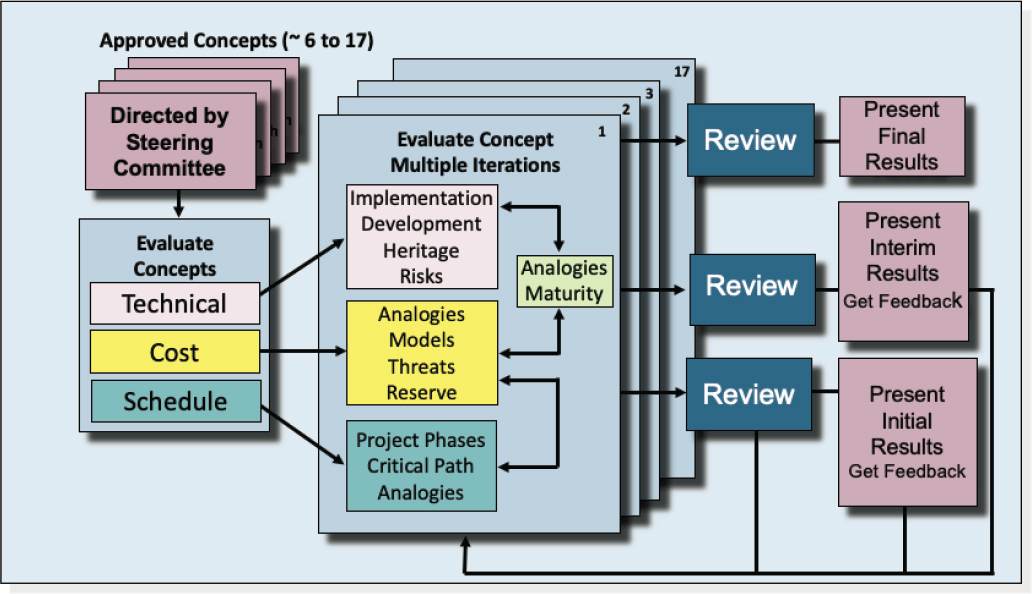
The TRACE team’s approach (Figure C-1) is based on the following principles:
- Use multiple methods and databases containing the pertinent details of past space systems so that no one model or dataset biases the results. Specifically, the TRACE team used proprietary Aerospace models (e.g., Small Satellite Cost Model, Missions Operations Cost Estimating Tool) and space-industry standards (e.g., NASA’s Project Cost Estimating Capability).
- Use analogy-based estimating; tie costs and schedule estimates to NASA systems that have already been built with known cost and schedule.
- Use both system-level estimates as well as a build-up-to-system level by appropriately summing subsystem data so as not to underestimate system cost and complexity.
- Use verification tools to check cost and schedule estimates for internal consistency and risk assessment.
- Quantify the total threats to costs from schedule growth, the costs of maturing technology, additional scope, and the threat to costs owing to mass growth resulting in the need for a larger, more costly launch vehicle in an integrated fashion.
In summary, an analogy-based methodology estimates the costs of future systems by comparison to the known cost of systems that have previously been built. The TRACE process provides an independent estimate of cost and complexity of pre-Phase A, proof of mission concepts anchored with respect to previously built hardware informed by the NASA historical record of concept design growth. Thus, the TRACE process is designed to inform the decadal survey about the potential future impact of the concepts evaluated to best enable the prioritization of a balanced program within a defined future budget scenario. The use of multiple methods—for example, analogies and standard cost models—ensures that no one model or database biases the estimate. The use of system-level estimates and arriving at total estimated costs by statistically summing the costs of all individual work breakdown structure (WBS) elements ensures that elements are not omitted and that the system-level complexity is properly represented in the cost estimate.
The evaluation of technology, cost, and schedule are inextricably intertwined. However, it is easier to describe each element of the overall analysis (e.g., technical, schedule, and cost) separately, noting in each instance the linkages to the overall TRACE evaluation.
Technical Evaluation
The evaluation of technology readiness, risk, and maturity in the TRACE process focuses on identifying the most important technical threats to achieving the necessary mission performance and stated scientific goals. The assessment is limited to a consideration of the top-level technical maturity and risk. Deviations from the current state of the art, system and operational complexity, and integration concerns associated with the use of heritage components are identified. Technical maturity and the need for specific additional development are evaluated by the TRACE team by assessing the readiness levels of key technologies and hardware. Technical risk assessment also included available resource margins for the reference design, resilience of the program architecture, testing challenges, and operational requirements. During the assessment of technology risks and concept maturity, the technical, cost, and schedule teams interact so that technological threats can be translated into schedule and cost risks.
The technical evaluation phase of the TRACE process is limited to the identification of high-level technical risks that could potentially impact schedule and cost. The TRACE process places no cost cap on mission concepts and hence risk as a function of cost is not considered. Concept maturity and technical risk are evaluated by considering the ability of a concept to meet a specified performance with adequate mass, power, and performance margins, given the proposed launch date.
TRACE evaluations also assess proposed mass and power contingencies with respect to technical maturity using AIAA guidelines to achieve a consistent evaluation. If the TRACE technical team concludes that the proposed contingencies are insufficient, they are increased in accordance with historical data on mass and power growth as summarized in the AIAA guidelines. In some cases, growth in mass and power requirements necessitate the selection of a larger launch vehicles to execute the proposed mission. In addition, the need for a more capable launch vehicle—for example, to accommodate potential growth in mass and power requirements—are passed on to the TRACE cost and schedule teams for incorporation into their estimates.
Schedule Evaluation
To aid in the assessment of concept risk, independent schedule estimates are incorporated as part of the TRACE cost estimate. This is especially true for assessment of risk with respect to proposed mission development and execution timelines. Like the TRACE assessment of cost risk, schedule risk is also derived from analogies in the historical NASA record. Historical data from past analogous NASA missions, properly adjusted, are used to gauge the realism of the proposed durations of the development phases. Similarly, the time to critical mission reviews (e.g., PDR and CDR) and the time required for integration and testing are evaluated for each concept and contrasted with appropriate historical experience.
A statistical approach is used to create a schedule probability “S-curve”—that is, a curve of the probability that the development time will exceed some specific value as a function of that value. The overall schedule, as proposed, is then adjusted with the historical data in mind. If the proposed schedule for a particular mission cannot be met, the next available launch window is selected. Additional costs incurred because the proposed schedule cannot be met are then added to the total cost of the mission. The committee requested that the TRACE team use the 70th percentile value in its schedule estimate—that is, there is a 70 percent probability that the schedule will be shorter than indicated and a 30 percent probability that it will be longer.
Cost Evaluation
The primary goal of the TRACE cost evaluation is to provide independent estimates (in fiscal year 2025 dollars) that can be used to prioritize various concepts within the context of the expected NASA budgetary constraints for the coming decade (see Chapter 22). The TRACE team developed high-level cost estimates based
on the information provided by the various mission study teams with a focus on treating all projects equally. To be consistent for all concepts, the TRACE cost process allows an increase in cost resulting from increased contingency mass and power, increased schedule, increased required launch vehicle capability, and other cost threats depending on the concept maturity and specific risk assessment of a particular concept.
All cost assessments for the TRACE process are probabilistic in nature and are based on the NASA historical record and documented project lifecycle growth studies. Traditional S-curves of cost probability versus cost are provided for each concept with both the project estimate and the TRACE estimate at the 70th percentile indicated.
The focus of the TRACE costing process is to estimate the cost of conceptual hardware—for example, instruments, spacecraft bus, landers—using multiple analogies and cost models based on historical data (see Figure C-2). A probabilistic cost-risk analysis is employed to estimate appropriate cost reserves. Ensuring consistency across the range of concepts—from those that are immature to those that are significantly more mature—the cost estimates are updated and adjusted with information from the technical TRACE team with respect to mass and power contingencies, technical maturity and development risk, and potentially required additional launch vehicle capability. Using independent schedule estimates, costs are adjusted using appropriate “burn rates” (cost per month) to properly reflect the impact of schedule changes.
Last, the results are integrated, cross-checked, and verified for consistency before being presented to the survey committee.
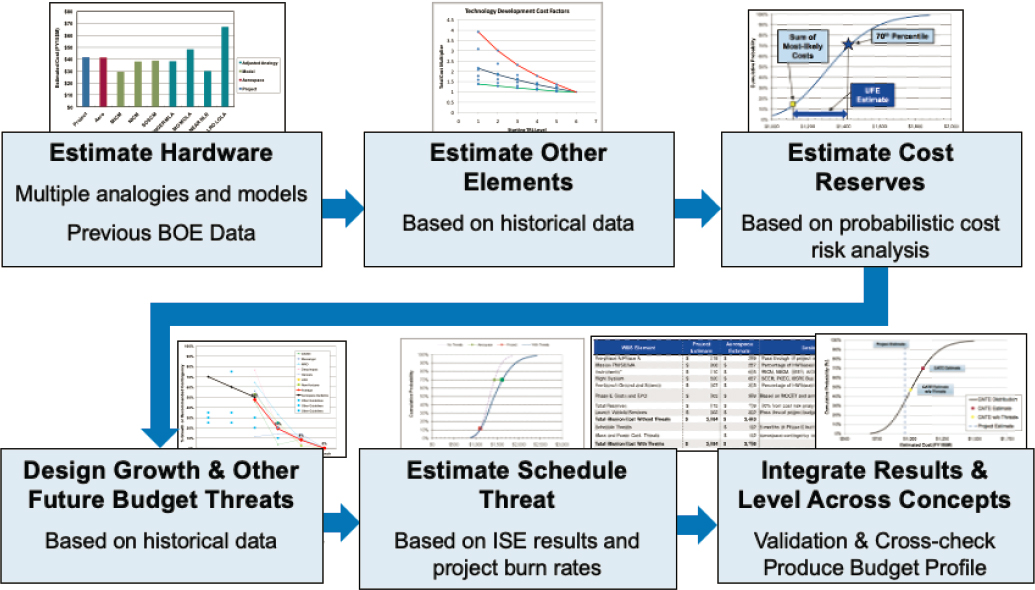
TRACE RESULTS FOR PRIORITY MISSIONS
Summaries of the results of the TRACE evaluations of the 17 priority missions identified by the decadal survey because of their potential to address the 12 key science goals (see Chapters 4 to 15) and potential technical viability presented in Boxes C-1 through C-18. These missions are as follows (not in priority order):
- Mercury Lander (Box C-1);
- Venus Flagship (Box C-2);
- Intrepid: lunar long-range rover traverse (Box C-3);
- Endurance: South Pole–Aitken Basin sample collecting rover (A-variant Box C-4, R-variant Box C-5);
- INSPIRE: In Situ Solar System Polar Ice Roving Explorer (Box C-6);
- Mars In Situ Geochronology (Box C-7);
- Mars Life Explorer (Box C-8);
- Ceres Sample Return (Box C-9);
- Europa Lander (Box C-10);
- Enceladus Orbilander (Box C-11);
- Enceladus Multiple Flyby (Box C-12);
- Titan Orbiter (Sea Probe Descoped) (Box C-13);
- Centaur Orbiter and Lander (Box C-14);
- Uranus Orbiter and Probe (Box C-15);
- Calypso: Uranus Moon and KBO Flyby (Box C-16);
- Odyssey: Neptune Orbiter and Probe (Box C-17); and
- Triton Ocean World Surveyor (Box C-18).
SUMMARY
The TRACE evaluation is a forward-looking technical readiness and budget (cost and schedule) evaluation process typically used to assess pre-Phase A mission concepts. Linked technical, cost, and schedule evaluations were developed for each of the priority mission concepts selected by the committee. The use of historical databases and evaluation of the technical risk, cost, and schedule histories of analogous space systems that have already flown provide a high degree of confidence that the resulting assessments are realistic and credible.
The TRACE-process-derived mission costs are typically higher than the cost estimates provided by mission advocates and design center study teams. The reason for this is that project-derived cost estimates are typically done via a bottoms-up or “grass roots” approach, and beyond standard contingencies, they do not include probabilities of risk incurred by necessary redesigns, schedule slips, and other unforeseen required adjustments. In other words, these estimates typically do not account for the “unpleasant surprises” that historically happen in nearly all space mission developments.
TRACE evaluations include a probabilistic assessment of required reserves, assuming that the concept achieves the mass and power as allocated or constrained by the respective stated project contingencies within the schedule as stated by the project. In addition to these reserves, additional cost threats are also included that quantify potential cost growth based on design maturity (mass and power growth) and schedule growth. Potential cost threats for larger required launch vehicle capability are also included, if required. It is the combination of these reserves and cost threats that are often the main reason for the large differences between the TRACE evaluation and the project estimate, when they occur. Differences in the estimates for hardware costs (instruments and flight systems) can also be a contributing factor.
Cost increases and schedule slippage have plagued spacecraft missions since the dawn of the Space Age. As such, fiscal uncertainties are a significant threat to long-term planning and budget management. Even with the most careful evaluation, the ultimate cost of a spacecraft is poorly constrained until relatively late in its development cycle. As a result, a decadal survey assessing concepts in their earliest phases of development faces a quandary: Throw caution to the wind and accept the assurance of mission advocates that their concept is doable within a specific cost and schedule, or adopt a specific approach to program evaluation. While not a panacea, the TRACE process’s use of the history record of “unpleasant surprises” provides the best tool currently available to add a degree of realism to long-term program planning.
BOX C-1
|
|
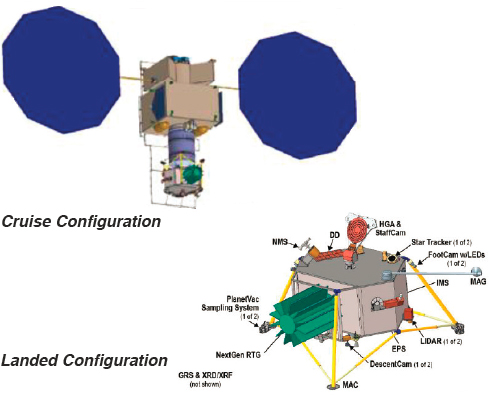 |
Scientific Objectives as Studied
Geochemistry: Investigate the mineralogy and chemistry of Mercury’s surface Geophysics: Characterize Mercury’s interior structure and magnetic field Space Environment: Determine the active processes that produce Mercury’s exosphere and alter its regolith Geology: Characterize the landing site at a variety of scales and provide context for landed measurements |
|
Key Features
Lander (10.5-yr life, 10-yr cruise, 0.2-yr orbital mission, 0.3-yr landed mission) Payload: (11 instruments) Gamma-Ray Spectrometer (GRS), X-Ray Diffractometer/X-Ray Fluorescence Spectrometer (XRD/XRF), Magnetometer (MAG), Accelerometer/Short Period Seismometer, Neutral Mass Spectrometer (NMS), Ion Mass Spectrometer (IMS), Energetic Particle Spectrometer (EPS), Dust Detector (DD), Regolith Imagers, Panoramic Imager (StaffCam); Sampling System (PlanetVac) Flight System: Next Generation RTG, 4.5 A-hr battery, redundant avionics, X-Band and Ka-Band communications, liquid bipropellant system, sun shield Descent System: STAR 48 GXV solid rocket motor Orbital Stage: Liquid bipropellant system with OMAC and CCTCap thrusters, GN&C, 3 m2 solar array, 60 A-hr battery, sun shield Cruise Stage: Solar Electric Propulsion with 2× NEXT-C engines, 60 m2 Ultraflex solar array Launch: Falcon Heavy Expendable, nominal launch: March 2035 Orbit: 100 × 6,000 km orbit at Mercury followed by landing |
Key Challenges
Maintaining safe thermal control at close solar distance Conducting surface operations with limited communications Providing sufficient power for lander surface operations System mass multipliers with lander growth Technical Risk Rating Medium: Medium new development, adequate to optimistic margins, and/or medium risk of achieving major mission objectives as proposed |
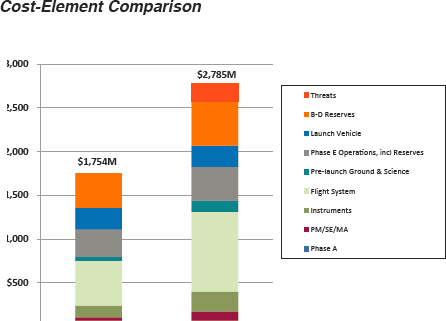 |
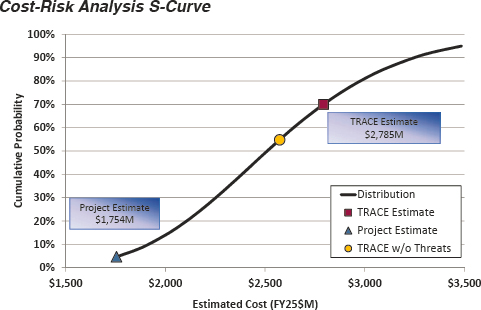 |
SOURCE: Images in upper-left box from NASA, 2020g, Mercury Lander: Transformative Science from the Surface of the Innermost Planet, Mission Concept Study Report for the Planetary Science and Astrobiology Decadal Survey 2023–2032, Columbia, MD: Johns Hopkins University Applied Physics Laboratory, https://science.nasa.gov/solar-system/documents.
BOX C-2
|
|
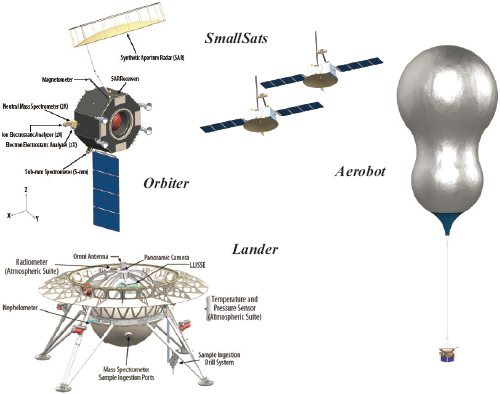 |
Scientific Objectives as Studied
Habitability: Understand the history of volatiles and liquid water on Venus and determine if Venus has ever been habitable Determine if Venus once hosted liquid water at the surface Identify and characterize the origins and reservoirs of Venus’s volatiles today Place constraints on whether there are habitable environments on Venus today and search for organic materials and biosignatures Climate: Understand the composition and climatological history of the surface of Venus and the present-day couplings between the surface and atmosphere Constrain surface composition and chemical markers of past and present climate Geology: Understand the geologic history of Venus and whether Venus is active today Determine if Venus shows evidence of a current or past plate tectonic regime Determine whether Venus is tectonically and volcanically active today |
|
Key Features
Orbiter (12.4-yr life) Payload (7 instruments): SAR, NIR-I, S-mm, Mag, NMS, ESA-I, ESA-e Flight System: Chemical propellant system, redundant avionics, solar powered SmallSats × 2 (6-yr life) Payload (7 instruments): LP, ESA-I, ESA-e, SEPD, Mag, EUV, E-Fd Flight System: Electric propulsion, solar powered, commercially procured Lander (6–8-hr mission life Lander, 60-day for LLISSE) Payload (11 instruments): NMS, TLS, AS, NI, GRS, Nephelometer, XRD, XFS, PC, Raman-LIBS, LLISSE Flight System: 4-leg lander, 4-fan divert system, drill, and sample handling system Aerobot (60-day mission life) Payload (5 instruments): AMS-N, FM, Mag, MET, VI Flight System: Variable altitude (52–62 km) helium balloon system, solar powered Launch Falcon Heavy, nominal launch: 2031 |
Key Challenges
Lander design for hazards in challenging landing environment Lander sample collection and handling at Venus surface with mission time constraints Advanced small satellite development for multi-year Venus mission Mission complexity for technology development and coordinated operations Technical Risk Rating Medium-High: Significant new development, optimistic to negative margins, and/or significant risk of achieving major mission objectives Descope Options Deleting the Aerobot and the two SmallSats reduces the estimated cost to ~$5,700 million Deleting the Lander and the two SmallSats reduces the estimated cost to ~$3,800 million |
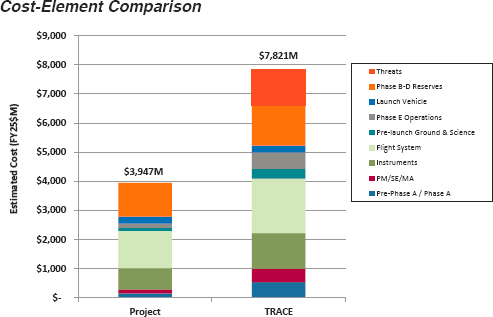 |
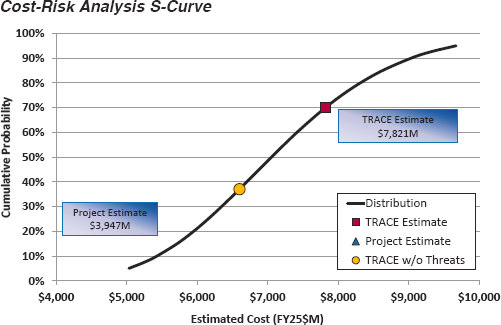 |
SOURCE: Images in upper-left box from NASA, 2020k, 2020 Venus Flagship Mission Study: A Mission to Explore the Habitability of Venus and the Origins of Earth-Sized Planets Both Near and Far, Mission Concept Study Report for the Planetary Science and Astrobiology Decadal Survey 2023–2032, Greenbelt, MD: NASA Goddard Space Flight Center, https://science.nasa.gov/solar-system/documents.
BOX C-3
|
|
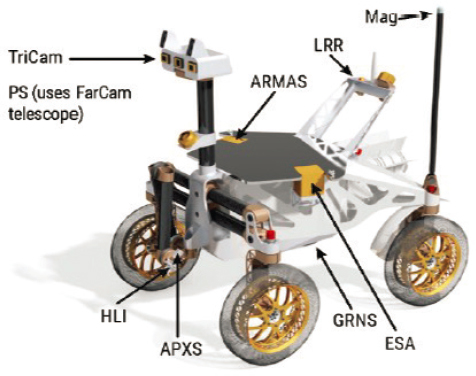 |
Scientific Objectives as Studied
Evolution of the Lunar Interior and Nature of the Procellarum KREEP Terrane: Determine the cause of extended volcanism in the Procellarum region Determine the cause of the lunar crustal asymmetry Test hypotheses for the origin of non-basaltic volcanism Determine the composition of deep mantle pyroclastic deposits Determine decline of core dynamo and magnetic field over time Diversity of Styles of Magmatism: Characterize flood basalt emplacement, rilles, flows, and vents Determine origin and composition of cones, domes, and shields Characterize pyroclastic volcanism processes: composition and physical state Determine the relationship between intrusive and effusive materials Post-Emplacement Modification of Magmatic Materials: Test hypotheses of impact crater formation, ballistic sedimentation, ray formation Determine target material influence on impact crater formation Determine the causes of magnetic anomalies, swirls, and space weathering |
|
Key Features
Rover (4-yr life) Payload: (8 instruments + retroreflector) TriCam (pair of color stereo imagers and single monochromatic narrow angle camera), Point Spectrometer (PS), Hand Lens Imager (HLI), Alpha Particle X-ray Spectrometer (APXS), Magnetometer (MAG), Gamma Ray and Neutron Spectrometer (GRNS), Automated Radiation Measurements for Aerospace Safety (ARMAS), Electrostatic Analyzer (ESA), Laser Retroreflector (LRR) Robotic Arm: 5-DOF robotic arm for placement of APXS and HLI Rover: 4-wheeled rover with passive suspension and dual-sided rocker, system powered by Mod 2 NGRTG (12 GPHS) and battery, Direct to Earth communications in S-band, Warm Electronics Box for avionics, combination of aluminum and carbon fiber structure Launch Delivered via: NASA Commercial Lunar Payload Services (launch and medium-class lander), nominal launch: April 2030 Destination: Land near Lunar Reiner Gamma formation and traverse to Irregular Mare Patch near Aristarchus Crater |
Key Challenges
Availability of NGRTG Mod 2 in time for mission Long-range traverse with high degree of autonomy Impact of dust on rover performance over time Technical Risk Rating Medium-Low: Moderate new development, adequate margins, and/or moderate risk to achieve major mission objectives as proposed |
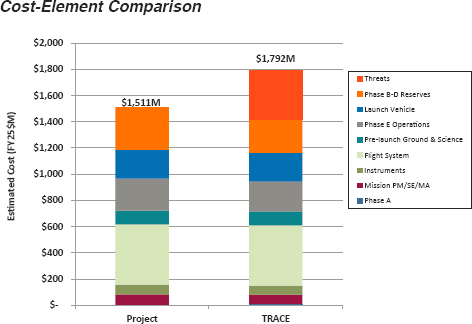 |
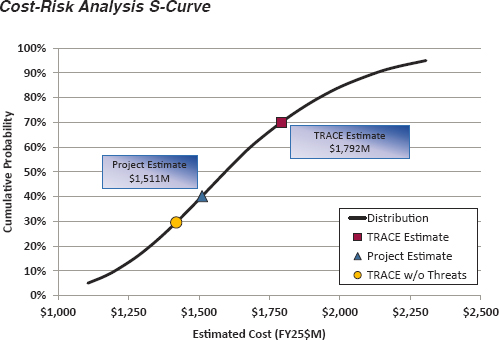 |
SOURCE: Image in upper-left box from NASA, 2020c, Intrepid Planetary Mission Concept Study Report, Mission Concept Study Report for the Planetary Science and Astrobiology Decadal Survey 2023–2032, Pasadena, CA: Jet Propulsion Laboratory, California Institute of Technology, https://science.nasa.gov/solar-system/documents.
BOX C-4
|
|
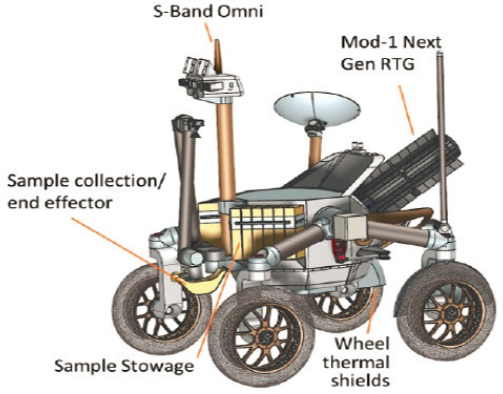 |
Scientific Objectives as Studied
Solar System Chronology: Anchor the earliest impact history of the solar system by determining the age of the largest and oldest impact basin on the Moon, the South Pole–Aitken basin Test the giant planet instability, impact cataclysm, and late heavy bombardment hypothesis by determining when large far side lunar impact basins formed Anchor the “middle ages” of solar system chronology (between 1 and 4 billion years ago) by determining the absolute age of a cratered, far side lunar mare basalt Planetary Evolution: Test the magma ocean paradigm and characterize the thermochemical evolution of terrestrial planets by determining the age and nature of volcanic features and compositional anomalies on the far side of the Moon Explore a giant impact basin from floor to rim by characterizing the geologic diversity across the South Pole–Aitken basin |
|
Key Features
Rover: Four-wheeled rover with passive suspension and dual-sided rocker, system powered by Mod 1 NGRTG and battery, comm uplink/downlink to/from commercial relay in S-band, Warm Electronics Box for avionics, combination of aluminum and carbon fiber structure. (4-yr life) Payload: (8 instruments + retroreflector) TriCam (pair of color stereo imagers and single monochromatic narrow angle camera), Point Spectrometer (PS), Hand Lens Imager (HLI), Alpha Particle X-ray Spectrometer (APXS), Magnetometer (MAG), Gamma Ray and Neutron Spectrometer (GRNS), Automated Radiation Measurements for Aerospace Safety (ARMAS), Electrostatic Analyzer (ESA), Laser Retroreflector (LRR) Sampling System: 5-DOF robotic arm with scoop and sieve end effector, side-mounted cache capable of storing 100 kg of samples in 12 astronaut-removable containers Launch: Delivered via NASA Commercial Lunar Payload Services (launch and medium-class lander), nominal launch: April 2030 Destination: Lunar South Pole–Aitken Basin |
Key Challenges
Long-range traverse with high degree of autonomy Limit of cargo mass on commercial lunar landers Impact of dust on rover performance over time Reliance on uncertain commercial lunar communications relay service Availability of Mod 1 NGRTG in time for mission Technical Risk Rating Medium: Medium new development, adequate to optimistic margins, and/or medium risk of achieving major mission objectives as proposed |
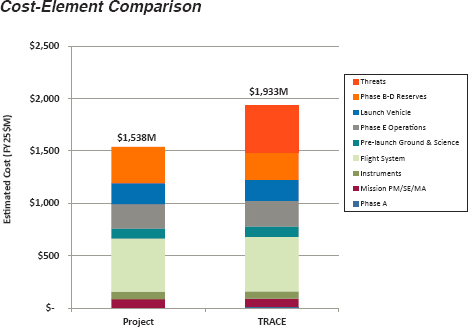 |
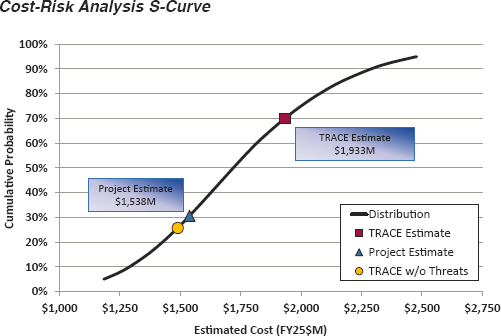 |
SOURCE: Image in upper-left box from NASA, 2021f, Endurance: Lunar South Pole–Aitken Basin Traverse and Sample Return Rover, Mission Concept Study Report for the Planetary Science and Astrobiology Decadal Survey 2023–2032, Pasadena, CA: Jet Propulsion Laboratory, California Institute of Technology, https://tinyurl.com/2p88fx4f.
BOX C-5
|
|
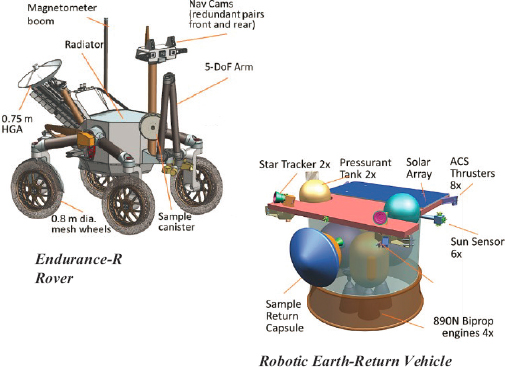 |
Scientific Objectives as Studied
Solar System Chronology: Anchor the earliest impact history of the solar system by determining the age of the largest and oldest impact structure on the Moon: South Pole–Aitken basin Test the giant planet instability, impact cataclysm, and late heavy bombardment hypotheses by determining when large far side lunar impact basins formed Anchor the “middle ages” of solar system chronology (between 1 and 4 billion years ago) by determining the absolute age of a cratered, far side lunar mare basalt Planetary Evolution: Test the magma ocean paradigm and characterize the thermochemical evolution of terrestrial planets by determining the age and nature of volcanic features and compositional anomalies on the far side of the Moon Explore a giant impact basin from floor to rim by characterizing the geologic diversity across the South Pole–Aitken basin |
|
Key Features
Rover (4-yr life) Payload: (8 instruments + retroreflector) TriCam (pair of color stereo imagers and single monochromatic narrow angle camera), Point Spectrometer (PS), Hand Lens Imager (HLI), Alpha Particle X-ray Spectrometer (APXS), Magnetometer (MAG), Gamma Ray and Neutron Spectrometer (GRNS), Automated Radiation Measurements for Aerospace Safety (ARMAS), Electrostatic Analyzer (ESA), Laser Retroreflector (LRR) Sampling System: 5-DOF robotic arm with scoop and sieve end effector, sample canister with 12 separate chambers with build-in lids for holding 2.2 kg of samples Rover: 4-wheeled rover with passive suspension and dual-sided rocker, system powered by Mod 1 NGRTG and battery, comm uplink/downlink to/from commercial relay in S-band, Warm Electronics Box for avionics, combination of aluminum and carbon fiber structure Earth-Return Vehicle: (7-mo life) Sample Return Capsule (SRC), sample transfer arm, 2536 m/s delta V biprop, structure, GNC, avionics, 1.55 m2 array and Li-Ion battery Launch: Delivered via 2 × NASA Commercial Lunar Payload Services (launch and medium-to large class landers), nominal launch: April 2030 (Rover), 2034 (ERV) Destination: South Pole–Aitken Basin |
Key Challenges
Limit of cargo mass on available commercial lunar landers Long-range traverse with high degree of autonomy Impact of dust on rover performance over time Reliance on uncertain commercial lunar communications relay service Availability of NGRTG in time for mission Technical Risk Rating Medium: Medium new development, adequate to optimistic margins, and/or medium risk of achieving major mission objectives as proposed |
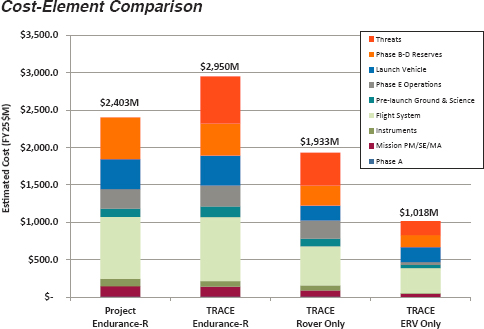 |
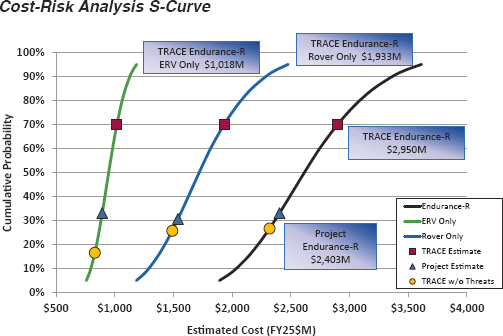 |
SOURCE: Images in upper-left box from NASA, 2021f, Endurance: Lunar South Pole–Aitken Basin Traverse and Sample Return Rover, Mission Concept Study Report for the Planetary Science and Astrobiology Decadal Survey 2023–2032, Pasadena, CA: Jet Propulsion Laboratory, California Institute of Technology, https://tinyurl.com/2p88fx4f.
BOX C-6
|
|
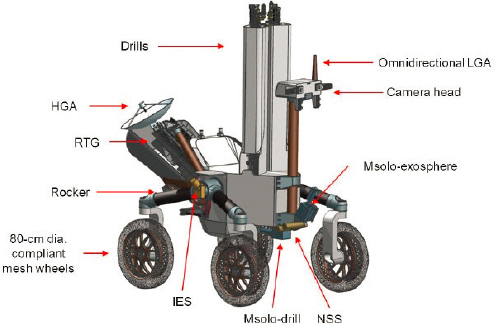 |
Scientific Objectives as Studied
Origins: Determine the origins of volatiles in the inner solar system Determine the abundance and distribution of lunar volatiles including water by measuring sulfur-bearing molecules, isotopic ratios, carbon-based molecules, and D/H ratios Use volatile distributions (lateral and vertical) and the physical form of volatiles to distinguish between sources including early outgassing, asteroid impacts, comet impacts, solar wind–regolith interactions, and ongoing small meteoroid bombardment Ages: Evaluate the timescales of volatile delivery in the inner solar system Determine the age of lunar volatiles by measuring the form and distribution and comparing with past and present-day environmental conditions Evolution: Assess how volatiles evolve on solar system airless bodies Determine how lunar volatiles have evolved over time by measuring the distribution of volatiles and correlating with environmental factors and geological context |
|
Key Features
Rover (3-yr life) Payload: (7 instrument types) Near IR Spectrometer (NIRVSS), Neutron Spectrometer (NSS), Mass Spectrometer (MSolo, Qty 2), Ion Electron Sensor (IES), Ground Penetrating Radar (Mini-GPR), Thermal IR Spectrometer (TIRS), Cameras Drill System: 2 m TRIDENT drill, including control electronics Rover: 4-wheeled rover with passive suspension and dual-sided rocker, system powered by Mod 1 NGRTG and battery, comm uplink/downlink to/from commercial relay in S-band, Warm Electronics Box for avionics, combination of aluminum and carbon fiber structure Launch: Delivered via NASA Commercial Lunar Payload Services (launch and medium-class lander), nominal launch: April 2030 Destination: Land at Cabeus crater and explore five permanently shadowed regions |
Key Challenges
Long-range traverse with high degree of autonomy Limit of cargo mass on commercial lunar landers Impact of dust on rover performance over time Reliance on uncertain commercial lunar communications relay service Availability of Mod 1 NGRTG in time for mission Technical Risk Rating Medium: Medium new development, adequate to optimistic margins, and/or medium risk of achieving major mission objectives as proposed |
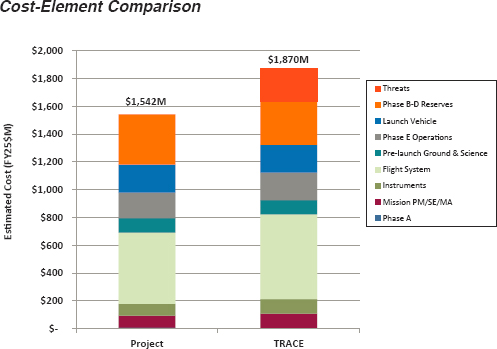 |
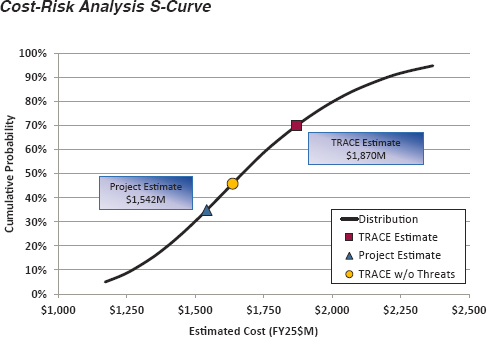 |
SOURCE: Image in upper-left box from NASA, 2021g, INSPIRE: IN Situ Solar System Polar Ice Roving Explorer, Mission Concept Study Report for the Planetary Science and Astrobiology Decadal Survey 2023–2032, Pasadena, CA: Jet Propulsion Laboratory, California Institute of Technology, https://tinyurl.com/2p88fx4f.
BOX C-7
|
|
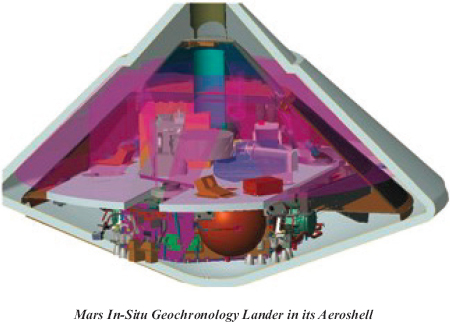 |
Scientific Objectives as Studied
Determine the chronology of basin-forming impacts to constrain the time period of heavy bombardment in the inner solar system and thus address fundamental questions related to inner solar system impact processes and chronology Reduce the uncertainty for inner solar system chronology in the “middle ages” (1–3 Ga) to improve models for planetary evolution, including volcanism, volatiles, and habitability Establish the history of habitability across the solar system Calibrate the body-specific chronology for Mars |
|
Key Features
Lander (40-mo life: 27.5-mo cruise, 11-mo data collection, 1.5-mo data downlink) Science Payload: Sampling/Engineering: Lander Bus: 5.1 m2 Ultraflex array, 2×25 Ahr Li Ion batteries, Hydrazine propulsion, redundant avionics, UHF and X-Band communications, GNC Entry System: Enlarged aeroshell and backshell based on InSight and Viking parachute Cruise Stage: X-Band communications, 5 m2 fixed solar array, star trackers Launch: Atlas V 411, nominal launch: July 2030 Destination: Mars Surface, 21 deg N latitude |
Key Challenges
Lander mass increase impact on design of the entry, descent, and landing system Lander energy margin toward end of science operations Uncertainty in development instrumentation for this mission application Technical Risk Rating Medium-Low: Moderate new development, adequate margins, and/or moderate risk to achieve major mission objectives as proposed |
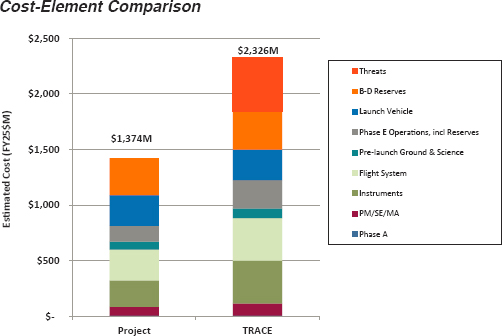 |
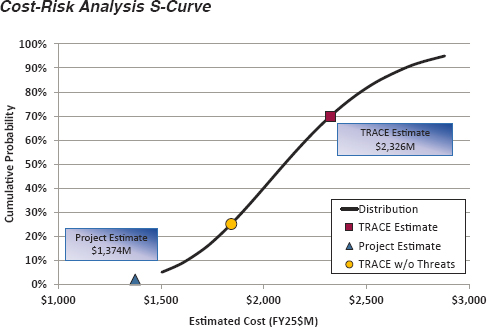 |
SOURCE: Image in upper-left box from NASA, 2020b, In Situ Geochronology for the Next Decade, Final Report Submitted in Response to NNH18ZDA001N-PMCS: Planetary Mission Concept Studies, Greenbelt, MD: NASA Goddard Space Flight Center, https://science.nasa.gov/solar-system/documents.
BOX C-8 Mars Life Explorer |
|
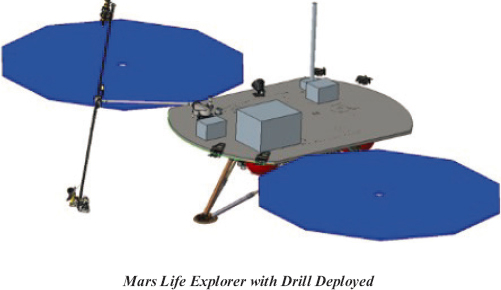 |
Scientific Objectives as Studied
Search for organic molecules, non-equilibrium gases, and isotopes associated with ice and regolith, and evaluate their possible biological origin Assess the habitability of the near-subsurface environment with respect to required elements to support microbial life, microbial energy sources, and compounds toxic to microbes Quantify the down borehole thermophysical properties of the ice/ice-cemented regolith and any role for liquid water in its creation or modification Determine the processes that preserve/modify/destroy these ice deposits in the modern climate |
|
Key Features
Lander (34-mo life: 10-mo cruise, 3-mo sample, 21-mo meteorology only) Science Payload: Sampling/Engineering: Lander Bus: 2×5.8 m2 Ultraflex array, 80 Ahr Li Ion battery, Hydrazine propulsion, redundant avionics, UHF and X-Band communications, GNC Entry System: 3.65 m diameter aeroshell, backshell Cruise Stage: X-Band communications, 5 m2 fixed solar array, star trackers Launch: Falcon Heavy Recoverable, nominal launch: May 2035 Destination: Martian surface, 40–50° north latitude |
Key Challenges
Challenge accessing near-surface ice with lander accuracy and drill mobility Lander mass increase beyond design limits of the entry, descent, and landing system Design variation due to science payload suite uncertainty Impact to power subsystem sizing from uncertainty in payload and concept of operations Technical Risk Rating Medium-Low: Moderate new development, adequate margins, and/or moderate risk to achieve major mission objectives as proposed |
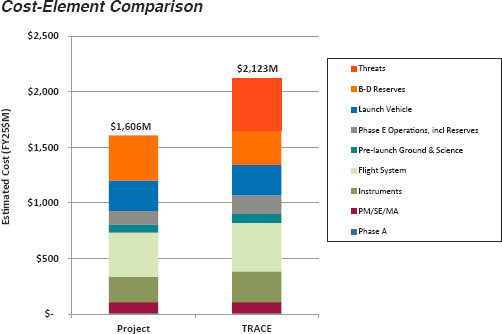 |
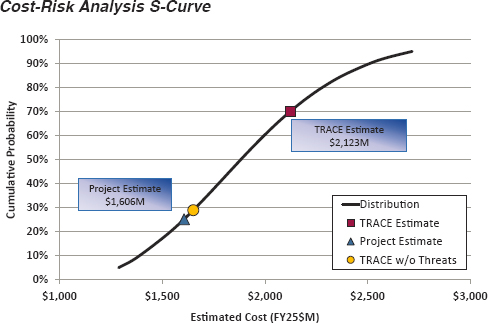 |
SOURCE: Image in upper-left box from NASA, 2021h, Mars Life Explorer, Mission Concept Study Report for the Planetary Science and Astrobiology Decadal Survey 2023–2032, Pasadena, CA: Jet Propulsion Laboratory, California Institute of Technology, https://tinyurl.com/2p88fx4f.
BOX C-9
|
|
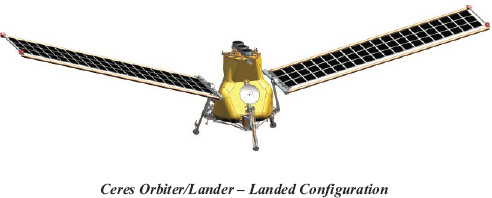 |
Scientific Objectives as Studied
Test if extrusion from a brine-rich mantle occurred during Ceres’s recent history Test if endogenic activity is ongoing at Occator crater Determine the depth of liquid water below Occator crater Characterize Ceres’s deep brine environment at Occator crater Characterize the evolution of organic matter in long-lived brines Determine Ceres’s accretional environment |
|
Key Features
Hybrid Orbiter/Lander (13.5-yr life, 6.3-yr outbound cruise, 1.4-yr orbital mission, 3-wk landed mission, 5.75-yr inbound cruise) Payload: Flight System: 3× NEXT thruster electric propulsion, Hydrazine propellant system, powered by 95 m2 roll-out solar array (ROSA) (two-axis gimballed) and 126 A-hr Li Ion battery, X-band communications, GNC with Terrain Relative Navigation, redundant avionics, Sample Return Capsule (SRC) Launch: Falcon Heavy Recoverable, nominal launch: Dec 2030 Orbit: 275 km and 28 km orbit at Ceres followed by landing, ascent, and return to Earth |
Key Challenges
New use of large ROSA for hybrid orbiter/lander mission Lack of definition for sample handling and preservation Uncertainty in sample collection requirements and approach Lack of definition for surface energy generation and usage Technical Risk Rating Medium: Medium new development, adequate to optimistic margins, and/or medium risk of achieving major mission objectives as proposed |
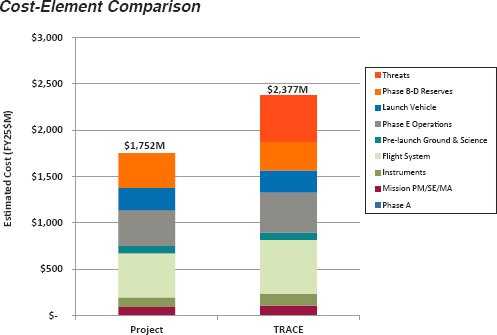 |
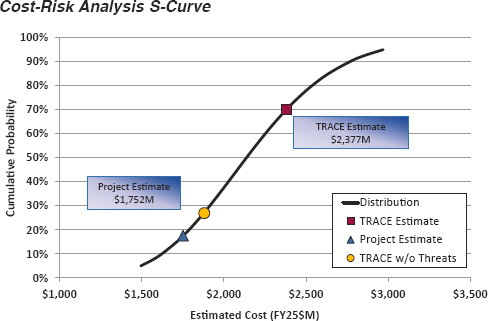 |
SOURCE: Image in upper left hand box from NASA, 2020h, Mission Concept Study: Ceres: Exploration of Ceres’Habitability. Mission Concept Study Report for the Planetary Science and Astrobiology Decadal Survey 2023–2032. Pasadena, CA: Jet Propulsion Laboratory, California Institute of Technology. https://science.nasa.gov/solar-system/documents.
BOX C-10
|
|
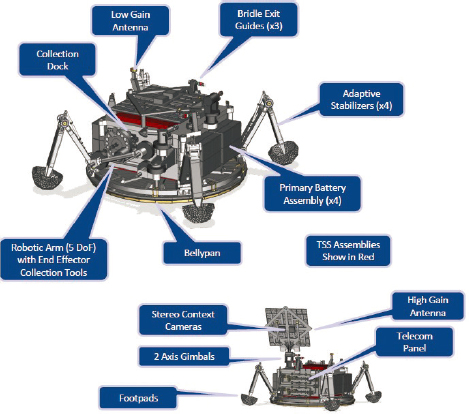 |
Scientific Objectives as Studied
Biosignatures: Search for evidence of biosignatures on Europa Identify potential biosignatures through a minimum of 9 lines of evidence: organic abundance, organic patterns, chirality, isotopes, microscale structures, macroscale structures, cellular properties, and biominerals Habitability: Assess the habitability of Europa via in situ techniques Characterize non-ice composition of Europa’s near-surface material to determine whether there are environmental factors essential for life Determine the proximity to liquid water and recently erupted materials at the lander’s location Surface Properties and Dynamics: Characterize the surface and subsurface of Europa Observe properties of surface materials and connect local properties with those seen from remote sensing Characterize dynamic processes of Europa’s surface and ice shell over the mission duration |
|
Key Features
Carrier Stage (7-yr life) Flight System: Chemical propellant system, 127 m2 solar array, X-band communications, radiation vaults to protect avionics, radiation TID 1.5 Mrad, Bio Barrier for Lander Deorbit Stage Flight System: Solid rocket motor with 5,000–5,700 kN-s total impulse, reference design based on Star-48 motor, system includes thermal and separation hardware Descent Stage: Flight System: Hydrazine monopropellant system with 410 kg propellant, redundant avionics and GNC with Terrain Relative Navigation (TRN) including LIDAR Europa Lander: (22-day surface mission) Payload (5 instruments): Organic Composition Analyzer, Vibrational Spectrometer, Microscope for Life Detection, Context Remote Sensing Imager, Geophysical Sounding System Flight System: Sample collection system, sterilization subsystem, Direct to Earth communications, primary battery, vault-enclosed avionics, radiation TID 2.0 Mrad Launch: SLS Block 1B, nominal launch: Nov 2026 |
Key Challenges
Lander science operation within energy and thermal constraints Landing safely on uneven and uncertain terrain Long-range direct to Earth downlink of science data from lander Lander and instrument contamination control for biosignatures science System mass multipliers with hardware growth Technical Risk Rating Medium: Medium new development, adequate to optimistic margins, and/or medium risk of achieving major mission objectives as proposed |
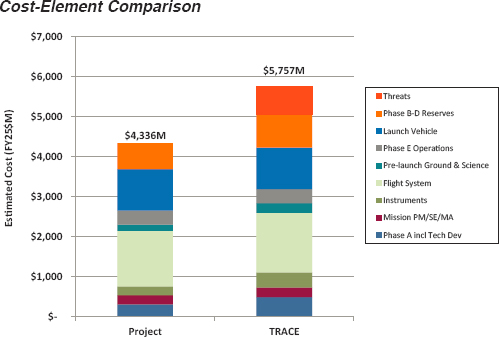 |
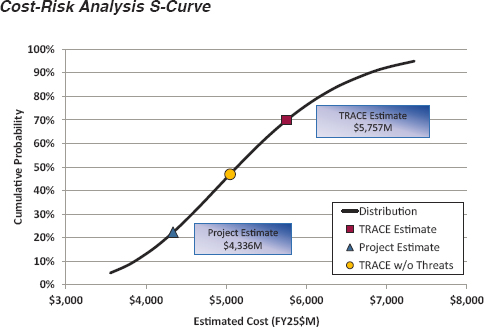 |
SOURCE: Images in upper-left box from NASA, 2017b, Report of the Europa Lander Science Definition Team, Washington, DC, https://europa.nasa.gov/resources/58/europa-lander-study-2016-report.
BOX C-11
|
|
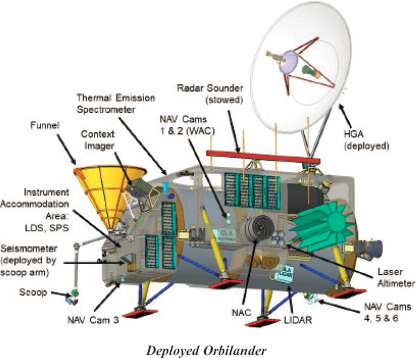 |
Scientific Objectives as Studied
Determine If Enceladus Is Inhabited: Search for biosignatures Characterize amino acids and lipids Assess to What Extent Enceladus’s Ocean Is Able to Sustain Life and Why: Provide geochemical and geophysical context for life detection Quantify physical and chemical environment Determine internal structure, vent structures Find Locations to Land and Actively Sample: Balance science, safety, and planetary protection Find a scientifically compelling landing site with a sufficiently high plume fallout rate Perform reconnaissance for both safe landing and active sampling Find sites with adeqVuate surface temperature to avoid melt through ice crust |
|
Key Features
Orbilander (10.5-yr life, 7-yr cruise, 1.5-yr orbital mission, 2-yr landed mission) Payload: Flight System: Chemical bi-propellant system, powered by 2x NGRTGs with battery, X-band/Ka-band Direct to Earth communications, GNC with Terrain Relative Navigation (TRN), redundant avionics Launch: SLS Block 2B with Castor 30B upper stage, nominal launch: Oct 2038 Falcon Heavy Expendable (FHE), nominal launch: September 2037, backup December 2038 (adds roughly 2 years to cruise phase for alternate trajectory) Orbit: 12-hr halo orbit at Enceladus |
Key Challenges
Complexity of TRN + pitch-over landing strategy Lander/Instrument contamination control for life detection Orbilander sample collection and handling Lander/Instrument concept growth in mass and complexity Technical Risk Rating Medium: Medium new development, adequate to optimistic margins, and/or medium risk of achieving major mission objectives as proposed |
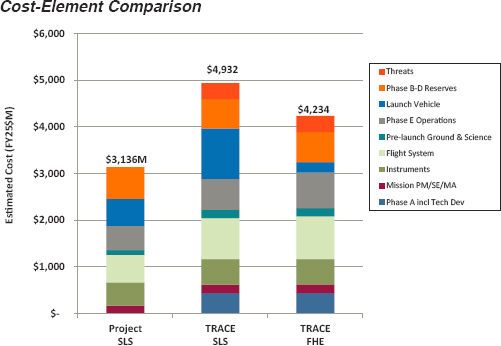 |
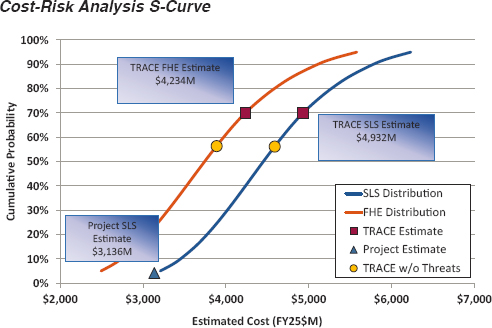 |
SOURCE: Image in upper-left box from NASA, 2020a, Enceladus Orbilander: A Flagship Mission Concept for Astrobiology, Mission Concept Study Report for the Planetary Science and Astrobiology Decadal Survey 2023–2032, Columbia, MD: Johns Hopkins University Applied Physics Laboratory, https://science.nasa.gov/solar-system/documents.
BOX C-12
|
|
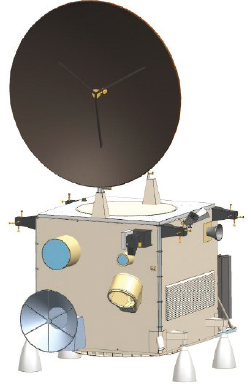 |
Scientific Objectives as Studied
Search for Signs of Life in Enceladus Plume Materials: Search for multiple features of life (biosignatures) Multiple, independent measurements of molecular qualities in organic compounds Assess the Habitability of the Enceladus Ocean: Quantitative measurements of key habitability parameters including sources of essential elements and micronutrients, sources of chemical energy, and key physiochemical parameters Characterize Enceladus’s Cryovolcanic Activity: Observe details of the structure of Enceladus plume and how it varies in space and time, including a more precise estimation of the relative contributions of jets and curtains to the overall plume |
|
Key Features
Flyby Vehicle (12-yr life, 9-yr cruise, 3-yr repeat flyby mission) Payload: Sampling Handling System: Collects icy grains from Enceladus plume and delivers to OCA and ICA instruments Flight System: Chemical bi-propellant system, powered by 2x NGRTGs with battery, Ka-band communications, 3-axis controlled GNC, redundant avionics Launch: Falcon Heavy Expendable, nominal launch: Oct 2038 Orbit: Multiple flybys at >50 km and <50 km altitude at Enceladus |
Key Challenges
NGRTG performance at required power output for mission Flyby plume sample collection and handling system development Orbilander sample collection and handling Instrument contamination control for biosignature detection Technical Risk Rating Medium-Low: Moderate new development, adequate margins, and/or moderate risk to achieve major mission objectives as proposed |
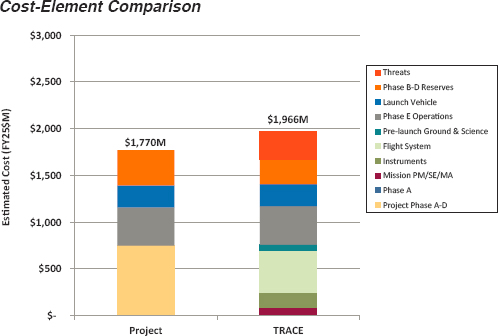 |
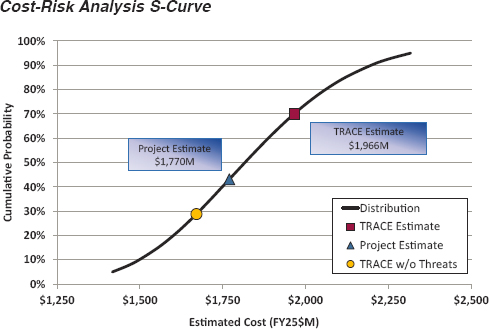 |
SOURCE: Image in upper-left box from NASA, 2021e, Enceladus Multiple Flybys: Is There Life Beyond Earth? Mission Concept Study Report for the Planetary Science and Astrobiology Decadal Survey 2023–2032. Greenbelt, MD: NASA Goddard Space Flight Center. https://tinyurl.com/2p88fx4f.
BOX C-13
|
|
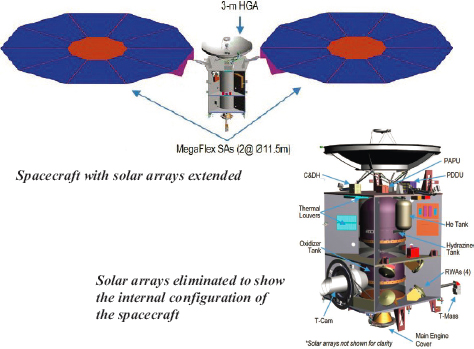 |
Scientific Objectives as Studied
Geology: Understand the processes actively shaping Titan’s surface Geophysics: Understand Titan’s interior structure and surface–interior exchange processes Astrobiology/Chemistry: Understand Titan’s organic chemistry and path to prebiotic molecules Atmosphere: Understand Titan’s climate as a source of surface modification |
|
Key Features
Orbiter (14-yr life: 10-yr cruise phase, 2-yr Saturn tour phase, 2-yr Titan orbit phase) Science Payload: Mass Spectrometer (T-MASS) for profiling Titan’s atmospheric constituents, Infrared Imager (T-CAM), Radar Altimeter (T-ALT) Orbiter Bus: 2 × 11.5 m diameter Megaflex array, 78 Ahr Li Ion battery, dual mode chemical propulsion, redundant avionics, X-Band, Ka-Band, and UHF communications, GNC Launch: Atlas V 551 or Falcon Heavy Recoverable, nominal launch: 2031 to 2039 Orbit: 2-yr Saturn tour with 20 flybys of Titan followed by 2 years at 1,500 km near polar orbit around Titan |
Key Challenges
Titan atmosphere uncertainty impact on flight system for aerosampling passes and possibly aerobraking Development and qualification of T-MASS hypervelocity aerosampling at Titan Development of Megaflex arrays for Titan mission application Technical Risk Rating Medium-Low: Moderate new development, adequate margins, and/or moderate risk to achieve major mission objectives as proposed |
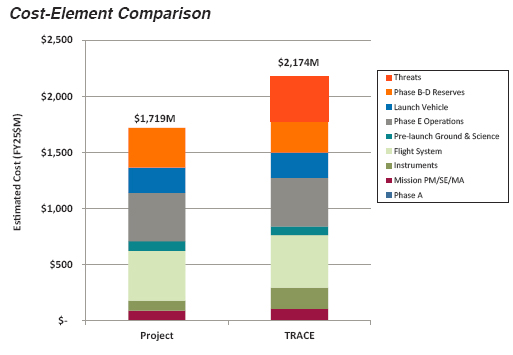 |
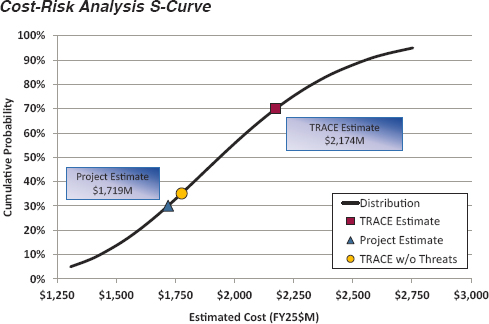 |
SOURCE: Images in upper-left box from NASA, 2021i, Titan Orbiter and Probe, Mission Concept Study Report for the Planetary Science and Astrobiology Decadal Survey 2023–2032, Pasadena, CA: Jet Propulsion Laboratory, California Institute of Technology, https://tinyurl.com/2p88fx4f.
BOX C-14
|
|
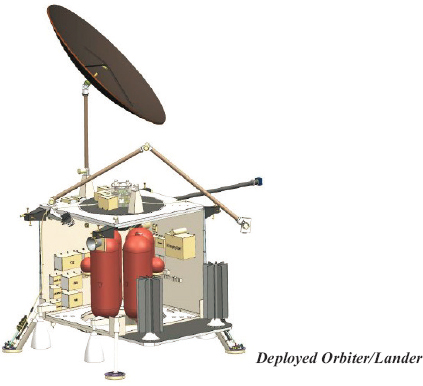 |
Scientific Objectives as Studied
Understand Early Solar System Compositional Reservoirs: Determine isotopic composition, large-scale mineralogical make-up, grain-scale composition, and interior volatile composition Understand the Accretion and Dynamical Evolution of Primordial Icy Planetesimals: Determine impact history and relative ages, physical characteristics of the body, internal mass distribution, and magnetism present during formation and accretion Determine the Geological and Evolutionary Processes That Have Influenced Icy Planetesimals: Determine landforms and any evidence of changes over the mission; icy regolith characteristics, surface weathering, source and cause of activity (if present), and characteristics of ring systems Investigate the Biologic Potential of Icy Planetesimals and Potential Brine Reservoirs: Determine the thermal history by looking for alteration minerals; determine the composition, form, and distribution of organic material. |
|
Key Features
Orbiter/Lander: (14-yr life, 9-yr cruise, 4-yr orbital mission, 2-mo nominal landed mission) Payload: (8 instrument types) Gas Chromatograph Mass Spectrometer (GCMS), Xray Fluorescence (XRF), Raman/UV Spectrometer, IR Spectral Imager, UV Spectral Imager, Narrow Angle Camera (x2), Wide Angle Camera, Magnetometer Sample Acquisition and Handling: PlanetVac-type sample collection (x2) with drill and pneumatic sample collection with carousel for handling Navigation Instruments: Navigation cameras, panoramic camera, LIDAR Flight System: Chemical bi-propellant system, system powered by NGRTG and Lion battery, Ka-band Direct to Earth communications, GNC with Terrain Relative Navigation (TRN), redundant avionics, landing anchor system Launch: Falcon Heavy Expendable, nominal launch: January 2040 Orbit: 50 km altitude polar mapping orbit at 2015 BQ311 Centaur |
Key Challenges
Low power margins during orbital phase and drilling Potential changes to vehicle configuration impacting design Impact of surface property unknowns on sampling and anchoring Technical Risk Rating Medium-Low: Moderate new development, adequate margins, and/or moderate risk to achieve major mission objectives as proposed |
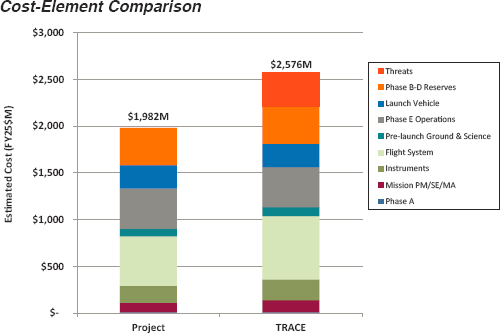 |
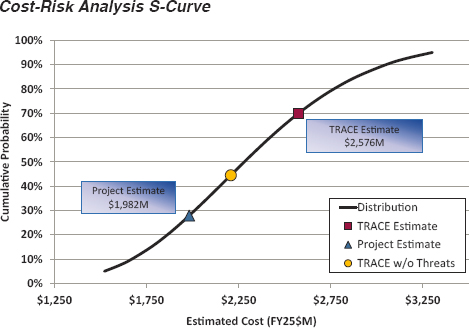 |
SOURCE: Image in upper-left box from NASA, 2021c, CORAL: Centaur Orbiter and Lander, Mission Concept Study Report for the Planetary Science and Astrobiology Decadal Survey 2023–2032, Greenbelt, MD: NASA Goddard Space Flight Center, https://tinyurl.com/2p88fx4f.
BOX C-15
|
|
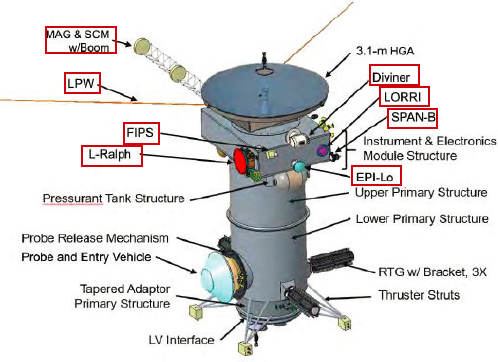 |
Scientific Objectives
Origins: When and where did Uranus form in the protosolar nebula? Did Uranus and Neptune migrate or swap positions? Did a giant impact tilt Uranus, rearrange its interior, and form satellites? Processes: Habitability: Interconnections: How do ice giant planets form and evolve in exoplanetary systems? How does solar wind couple to a magnetosphere with a rapidly changing orientation? |
|
Key Features Orbiter Payload: (9 instruments) Magnetometer (MAG), Narrow-Angle Camera, Thermal IR Camera, Langmuir Probe & Waves (LPW), Search Coil Magnetometer (SCM), Fast Imaging Plasma Spectrometer (FIPS), Solar Wind Electrons Alphas and Protons (SWEAP), Solar Probe Analyzer-B (SPAN-B), Energetic Particle Instrument (EPI-Lo), Vis/NIR Imaging Spectrometer & Wide-Angle Camera Flight System: Chemical propellant system, redundant avionics, powered by 3 x Next Generation Radioisotope Thermal Generators (NGRTGs) Mod 1 with secondary battery Probe (60-day mission) Payload: (3 instruments) Mass Spectrometer, Atmospheric Structure Instrument, Ortho-Para H2 Detector Flight System: HEEET TPS, primary battery, avionics, comm Launch: Falcon Heavy Expendable, nominal launch: 2031 Orbit: Uranus orbit with moon tour of Uranus system |
Key Challenges
Power margin sensitivity to mission trajectory/lifetime alternatives Flight system lifetime for 18.5-year mission Payload requirements growth leading to more complex mission Technical Risk Rating Medium-Low: Moderate new development, adequate margins, and/or moderate risk to achieve major mission objectives as proposed |
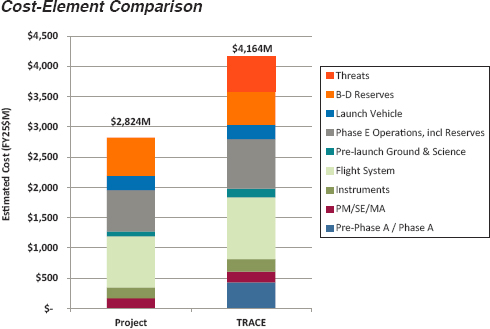 |
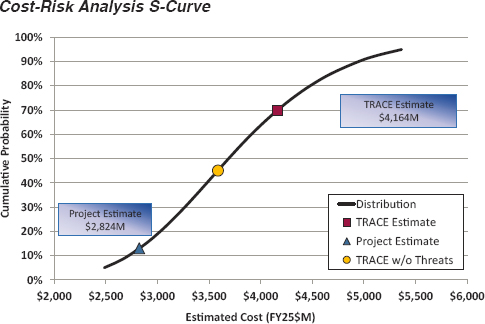 |
SOURCE: Image in upper-left box from NASA, 2021j, Uranus Orbiter and Probe: Journey to an Ice Giant System, Mission Concept Study Report for the Planetary Science and Astrobiology Decadal Survey 2023–2032, Columbia, MD: Johns Hopkins University Applied Physics Laboratory, https://tinyurl.com/2p88fx4f.
BOX C-16
|
|
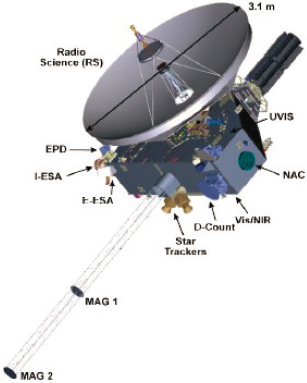 |
Scientific Objectives as Studied
Explore the Uranus System and Its Impact-Generated Moons: (potential ocean worlds) Search for Ariel subsurface ocean and internal structure Characterize Ariel crater populations Uranian System Science: Uranus, rings, ring-moons, and satellites Study Large Kuiper Belt Objects (KBOs): Characterize the global geology and morphology of KBOs and their rotational and physical properties Map G!kún||’hòmdímà surface composition and volatile distribution Characterize G!kún||’hòmdímà crater populations |
|
Key Features
Spacecraft: (17.1-yr life: 6-yr cruise to Uranian moon, 11-yr cruise to KBO) Science Payload: (8 instrument types + radio science) Vector Magnetometer (x2) (MAG), Narrow Angle Camera (NAC), Vis/NIR Imaging Spectrometer (Vis/NIR), Radio Science Experiment (RS), Ultraviolet Imaging Spectrometer (UVIS), Ion Electrostatic Analyzer (I-ESA), Electron Electrostatic Analyzer (E-ESA), Energetic Particle Detector (EPD), Dust Counter (D-Count) Spacecraft Bus: Powered by NGRTG Mod 0, 78 Ahr Li Ion battery, hydrazine propulsion, redundant avionics, X-Band and Ka-Band communications including 3.1 m high gain antenna, GNC Launch: Vulcan or Falcon Heavy, both with STAR 48BV kick stage, nominal launch: 2035 Orbit: Flyby of Uranian moon (nominally Ariel) followed by flyby of KBO 11 years later (nominally G!kún||’hòmdímà) |
Key Challenges
Low power margin, particularly if NGRTG Mod 0 is not available Mission destination bodies are uncertain and dependent on launch year Critical closest approach operations robustness is unclear for flyby Technical Risk Rating Medium-Low: Moderate new development, adequate margins, and/or moderate risk to achieve major mission objectives as proposed |
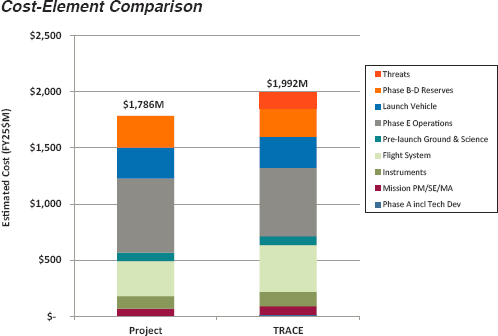 |
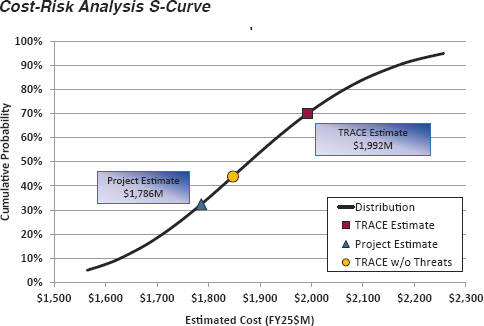 |
SOURCE: Image in upper-left box from NASA, 2021b, Calypso: In Search of Ocean Worlds in the Uranian System and Kuiper Belt, Mission Concept Study Report for the Planetary Science and Astrobiology Decadal Survey 2023–2032, Columbia, MD: Johns Hopkins University Applied Physics Laboratory, https://tinyurl.com/2p88fx4f.
BOX C-17
|
|
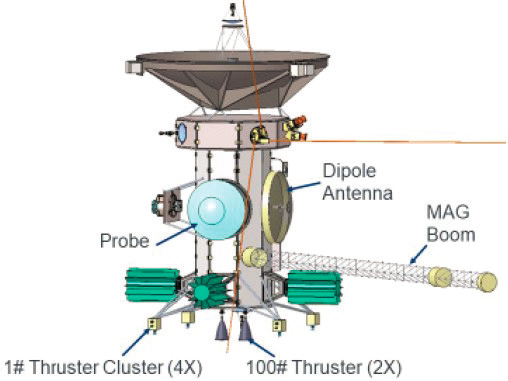 |
Scientific Objectives as Studied
Origins: Understand Neptune’s origin and how it evolved, placing it in context with other planetary types Particles and Fields: Study Neptune’s aurora and magnetic field to understand processes critical to the Neptune system, including exploring Triton’s interactions and whether Triton contains a subsurface ocean by observing auroral activity and magnetic induction Ocean Worlds: Study Triton’s surface, interior, atmosphere, and magnetic interaction with Neptune to determine if it is an ocean world, understand plume activity, and how Triton’s ionosphere is coupled with Neptune’s magnetosphere Comparative Planetology: Compare and contrast attributes of Triton with other Kuiper Belt objects for a better understanding of dwarf planets Satellite and Ring Systems: Understand Neptune’s ring-moon system |
|
Key Features
Orbiter (20-yr life) Payload (14 instruments): Magnetometer, Color Narrow-Angle Camera, UV Imaging Spectrograph, Ion and Neutral Mass Spectrometer, Laser Altimeter, Vis-NIR Imaging Spectrometer, Radio and Plasma Wave Detector, Thermal Infrared Imager, Microwave Radiometer, Thermal Plasma Spectrometer, Energetic Charged Particle Detector, Energetic Neutral Atom Imager, ToF Dust Spectrometer, EPO Camera Flight System: Chemical propellant system, redundant avionics, powered by 3 x Next Generation Radioisotope Thermal Generators (NGRTGs) Probe (30-day mission) Payload: (7 instruments) Mass Spectrometer, Atmospheric Structure Instrument, He Abundance Detector, Ortho-Para H2 Detector, Nephelometer, Net Flux Radiometer, EPO Camera Flight System: HEEET TPS, primary battery, avionics, communications system Launch: SLS Block 2 with Centaur Upper Stage, nominal launch: 2033 Orbit: Neptune orbit with repeat flybys of Triton |
Key Challenges
Availability of SLS Block 2 with Centaur upper stage NGRTG performance at required power output for mission HEEET TPS performance at mission peak pressure and heat flux Probe power growth and lifetime of primary batteries with long storage Complexity of large suite of instruments on an orbiter an a probe Technical Risk Rating Medium: Medium new development, adequate to optimistic margins, and/or medium risk of achieving major mission objectives as proposed |
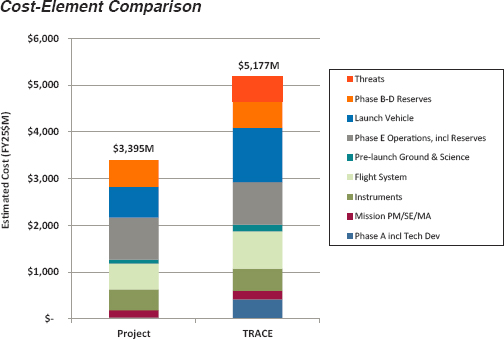 |
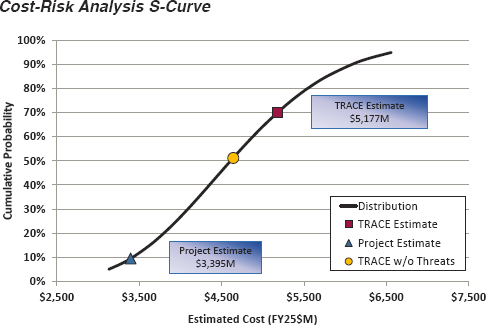 |
SOURCE: Image in upper-left box from NASA, 2020i, Neptune Odyssey: Mission to the Neptune-Triton System, Mission Concept Study Report for the Planetary Science and Astrobiology Decadal Survey 2023–2032, Columbia, MD: Johns Hopkins University Applied Physics Laboratory, https://science.nasa.gov/solar-system/documents.
BOX C-18
|
|
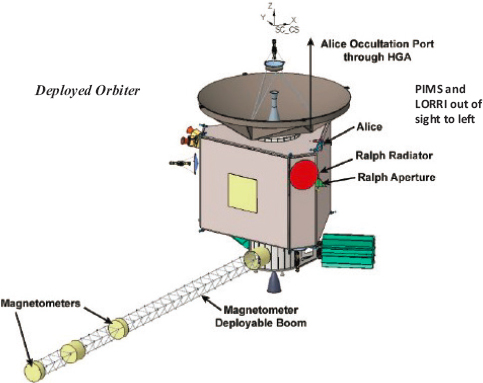 |
Scientific Objectives as Studied
Determine whether Triton is an ocean world, ascertain its interior structure, and decide whether Triton’s ice shell is in hydrostatic equilibrium and de-coupled from the interior Characterize Triton’s surface composition and geology, and look for changes, including plumes and their composition Determine the nature of the moon–magnetosphere interaction at Triton Determine the composition, density, temperature, pressure, and spatial/temporal variability of Triton’s atmosphere |
|
Key Features
Orbiter/Lander (20-yr life, 16-yr cruise, 4-yr orbital mission) Payload: (6 instruments) Flight System: Chemical bi-propellant system, system powered by NGRTG and battery, Ka-band and X-Band communications, redundant GNC, redundant avionics Launch: Orbit: |
Key Challenges
Lifetime reliability and power issues for long mission duration Availability of NGRTG Unplanned growth of instruments from model payload suite Technical Risk Rating Medium-Low: Moderate new development, adequate margins, and/or moderate risk to achieve major mission objectives as proposed |
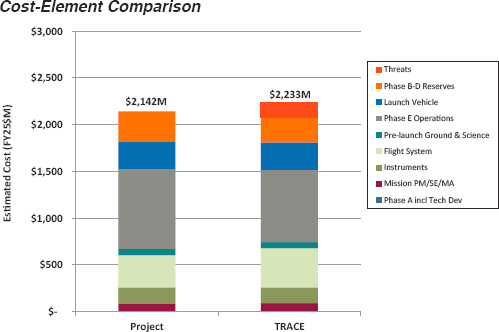 |
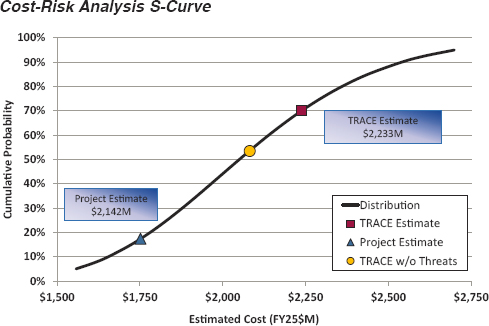 |
SOURCE: Image in upper-left box from NASA, 2021k, Triton Ocean World Surveyor: A Neptune Orbiter and Triton Explorer. Mission Concept Study Report for the Planetary Science and Astrobiology Decadal Survey 2023–2032. Columbia, MD: Johns Hopkins University Applied Physics Laboratory. https://tinyurl.com/2p88fx4f.
REFERENCES
NASA (National Aeronautics and Space Administration). 2015. Report from the Next Orbiter Science Analysis Group (NEX-SAG). MEPAG NEX-SAG Final Report. Pasadena, CA: MEPAG (Mars Exploration Program Analysis Group) NEX-SAG (Next Orbiter Science Analysis Group).
NASA. 2017a. Ice Giants Pre-Decadal Study Final Report. JPL D-100520. Pasadena, CA: Jet Propulsion Laboratory.
NASA. 2017b. Report of the Europa Lander Science Definition Team. Washington, DC. https://europa.nasa.gov/resources/58/europa-lander-study-2016-report.
NASA. 2019. MEPAG ICE-SAG Final Report (2019). Report from the Ice and Climate Evolution Science Analysis Group (ICE-SAG). Pasadena, CA: MEPAG (Mars Exploration Program Analysis Group).
NASA. 2020a. Enceladus Orbilander: A Flagship Mission Concept for Astrobiology. Mission Concept Study Report for the Planetary Science and Astrobiology Decadal Survey 2023–2032. Columbia, MD: Johns Hopkins University Applied Physics Laboratory. https://science.nasa.gov/solar-system/documents.
NASA. 2020b. In Situ Geochronology for the Next Decade. Final Report Submitted in Response to NNH18ZDA001N-PMCS: Planetary Mission Concept Studies. Greenbelt, MD: NASA Goddard Space Flight Center. https://science.nasa.gov/solar-system/documents.
NASA. 2020c. Intrepid Planetary Mission Concept Study Report. Mission Concept Study Report for the Planetary Science and Astrobiology Decadal Survey 2023–2032. Pasadena, CA: Jet Propulsion Laboratory, California Institute of Technology https://science.nasa.gov/solar-system/documents.
NASA. 2020d. The Lunar Geophysical Network. Final Report Submitted in Response to NNH18ZDA001N-PMCS: Planetary Mission Concept Studies. Greenbelt, MD: NASA Goddard Space Flight Center. https://science.nasa.gov/solar-system/documents.
NASA. 2020e. MORIE: Mars Orbiter for Resources, Ices, and Environments. Mission Concept Study Report for the Planetary Science and Astrobiology Decadal Survey 2023–2032. Pasadena, CA: Jet Propulsion Laboratory, California Institute of Technology. https://science.nasa.gov/solar-system/documents.
NASA. 2020f. MOSAIC: Mars Orbiters for Surface-Atmosphere-Ionosphere Connections. Mission Concept Study Report for the Planetary Science and Astrobiology Decadal Survey 2023–2032. Pasadena, CA: Jet Propulsion Laboratory, California Institute of Technology https://science.nasa.gov/solar-system/documents.
NASA. 2020g. Mercury Lander: Transformative Science from the Surface of the Innermost Planet. Mission Concept Study Report for the Planetary Science and Astrobiology Decadal Survey 2023–2032. Columbia, MD: Johns Hopkins University Applied Physics Laboratory. https://science.nasa.gov/solar-system/documents.
NASA. 2020h. Mission Concept Study: Ceres: Exploration of Ceres’ Habitability. Mission Concept Study Report for the Planetary Science and Astrobiology Decadal Survey 2023–2032. Pasadena, CA: Jet Propulsion Laboratory, California Institute of Technology. https://science.nasa.gov/solar-system/documents.
NASA. 2020i. Neptune Odyssey: Mission to the Neptune-Triton System. Mission Concept Study Report for the Planetary Science and Astrobiology Decadal Survey 2023–2032. Columbia, MD: Johns Hopkins University Applied Physics Laboratory. https://science.nasa.gov/solar-system/documents.
NASA. 2020j. Persephone: A Pluto-System Orbiter and Kuiper Belt Explorer. Mission Concept Study Report for the Planetary Science and Astrobiology Decadal Survey 2023–2032. Columbia, MD: Johns Hopkins University Applied Physics Laboratory. https://science.nasa.gov/solar-system/documents.
NASA. 2020k. 2020 Venus Flagship Mission Study: A Mission to Explore the Habitability of Venus and the Origins of Earth-Sized Planets Both Near and Far. Mission Concept Study Report for the Planetary Science and Astrobiology Decadal Survey 2023–2032. Greenbelt, MD: NASA Goddard Space Flight Center. https://science.nasa.gov/solar-system/documents.
NASA. 2021a. ADVENTS: Assessment and Discovery of Venus’ Past Evolution and Near-Term Climatic and Geophysical State. Mission Concept Study Report for the Planetary Science and Astrobiology Decadal Survey 2023–2032. Greenbelt, MD: NASA Goddard Space Flight Center. https://tinyurl.com/2p88fx4f.
NASA. 2021b. Calypso: In Search of Ocean Worlds in the Uranian System and Kuiper Belt. Mission Concept Study Report for the Planetary Science and Astrobiology Decadal Survey 2023–2032. Columbia, MD: Johns Hopkins University Applied Physics Laboratory. https://tinyurl.com/2p88fx4f.
NASA. 2021c. CORAL: Centaur Orbiter and Lander. Mission Concept Study Report for the Planetary Science and Astrobiology Decadal Survey 2023–2032. Greenbelt, MD: NASA Goddard Space Flight Center. https://tinyurl.com/2p88fx4f.
NASA. 2021d. CROCODILE: Cryogenic Return of Cometary Organics, Dust, and Ice for Laboratory Exploration. Mission Concept Study to Report to the Planetary Science and Astrobiology Decadal Survey 2023–2032. Greenbelt, MD: NASA Goddard Space Flight Center. https://tinyurl.com/2p88fx4f.
NASA. 2021e. Enceladus Multiple Flybys: Is There Life Beyond Earth? Mission Concept Study Report for the Planetary Science and Astrobiology Decadal Survey 2023–2032. Greenbelt, MD: NASA Goddard Space Flight Center. https://tinyurl.com/2p88fx4f.
NASA. 2021f. Endurance: Lunar South Pole-Aitken Basin Traverse and Sample Return Rover. Mission Concept Study Report for the Planetary Science and Astrobiology Decadal Survey 2023–2032. Pasadena, CA: Jet Propulsion Laboratory, California Institute of Technology. https://tinyurl.com/2p88fx4f.
NASA. 2021g. INSPIRE: In Situ Solar System Polar Ice Roving Explorer. Mission Concept Study Report for the Planetary Science and Astrobiology Decadal Survey 2023–2032. Pasadena, CA: Jet Propulsion Laboratory, California Institute of Technology. https://tinyurl.com/2p88fx4f.
NASA. 2021h. Mars Life Explorer. Mission Concept Study Report for the Planetary Science and Astrobiology Decadal Survey 2023–2032. Pasadena, CA: Jet Propulsion Laboratory. https://tinyurl.com/2p88fx4f.
NASA. 2021i. Titan Orbiter and Probe. Mission Concept Study Report for the Planetary Science and Astrobiology Decadal Survey 2023–2032. Pasadena, CA: Jet Propulsion Laboratory, California Institute of Technology. https://tinyurl.com/2p88fx4f.
NASA. 2021j. Uranus Orbiter and Probe: Journey to an Ice Giant System. Mission Concept Study Report for the Planetary Science and Astrobiology Decadal Survey 2023–2032. Columbia, MD: Johns Hopkins Applied Physics Laboratory. https://tinyurl.com/2p88fx4f.
NASA. 2021k. Triton Ocean World Surveyor: A Neptune Orbiter and Triton Explorer. Mission Concept Study Report for the Planetary Science and Astrobiology Decadal Survey 2023–2032. Columbia, MD: Johns Hopkins University Applied Physics Laboratory. https://tinyurl.com/2p88fx4f.
NASEM (National Academies of Sciences, Engineering, and Medicine). 2013. Lessons Learned in Decadal Planning in Space Science: Summary of a Workshop. Washington, DC: The National Academies Press.
NASEM. 2015. The Space Science Decadal Surveys: Lessons Learned and Best Practices. Washington, DC: The National Academies Press
NASEM. 2023. Pathways to Discovery in Astronomy and Astrophysics for the 2020s. Washington, DC: The National Academies Press.
NRC (National Research Council). 2006. An Assessment of Balance in NASA’s Science Programs. Washington, DC: The National Academies Press, p. 32.
NRC. 2007a. Decadal Science Strategy Surveys: Report of a Workshop. Washington, DC: The National Academies Press, pp. 21–30.
NRC. 2007b. NASA’s Beyond Einstein Program: An Architecture for Implementation. Washington, DC: The National Academies Press, pp. 66–114.
NRC. 2010. New Worlds, New Horizons in Astronomy and Astrophysics. Washington, DC: The National Academies Press, Appendix C.
NRC. 2011. Vision and Voyages for Planetary Science in the Decade 2013–2022. Washington, DC: The National Academies Press, pp. 331–353.
NRC. 2013. Lessons Learned in Decadal Planning in Space Science: Summary of a Workshop. Washington, DC: The National Academies Press.
U.S. Congress, House. 2008. National Aeronautics and Space Administration Authorization Act of 2008. Public Law 110-422. H.R. 6063. 110th Congress, Section 1104b.
Venera-D Joint Science Definition Team. 2019. Venera-D: Expanding Our Horizon of Terrestrial Planet Climate and Geology through the Comprehensive Exploration of Venus. Phase II Final Report of The Venera-D Joint Science Definition Team. Washington, DC: NASA Headquarters and Moscow, Russia: Space Research Institute.





